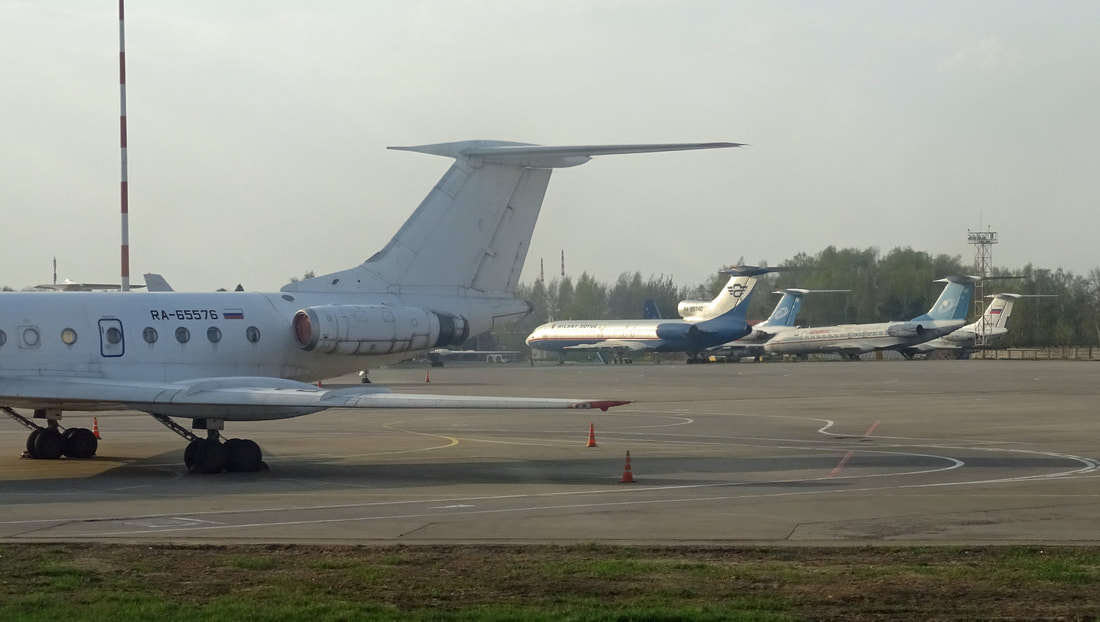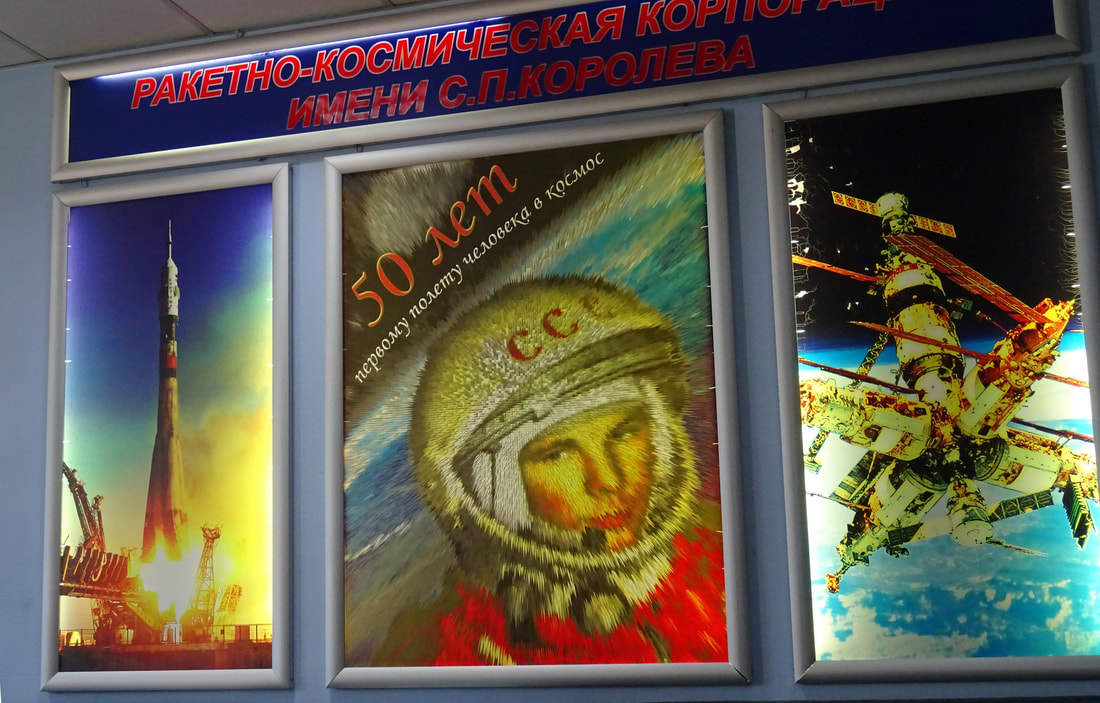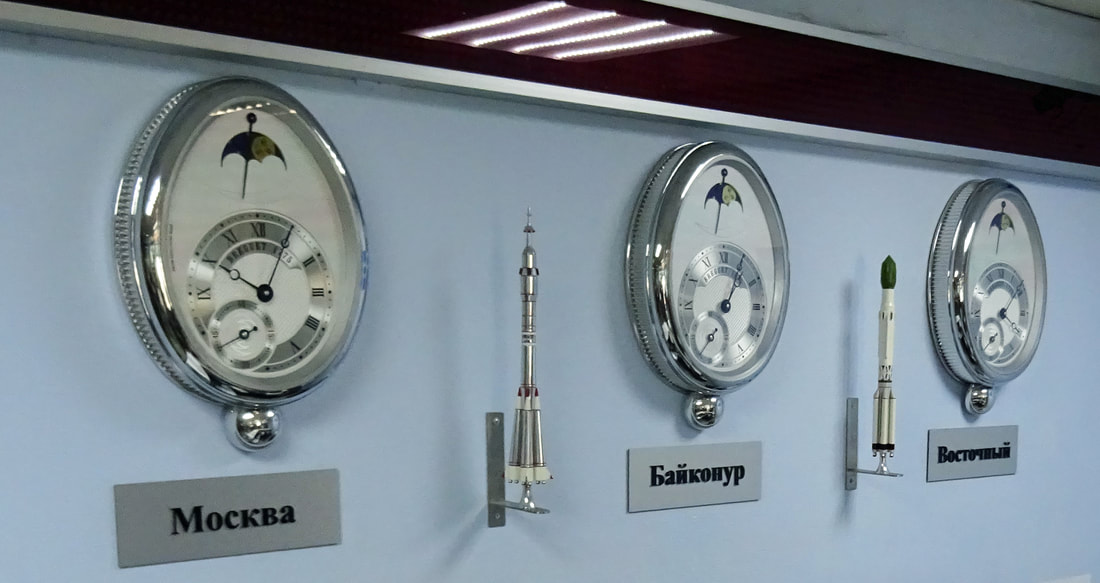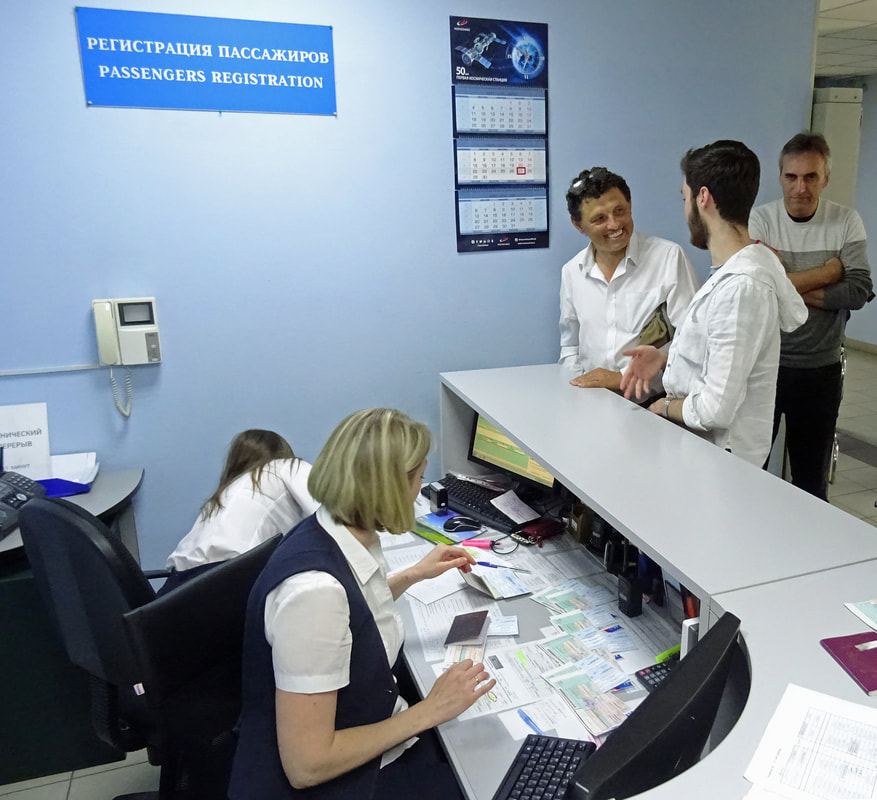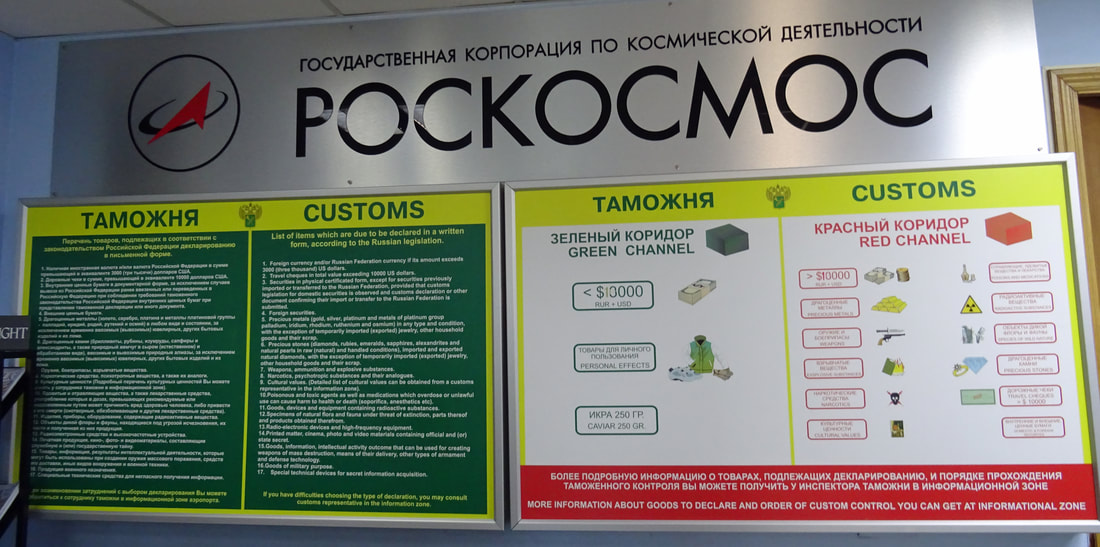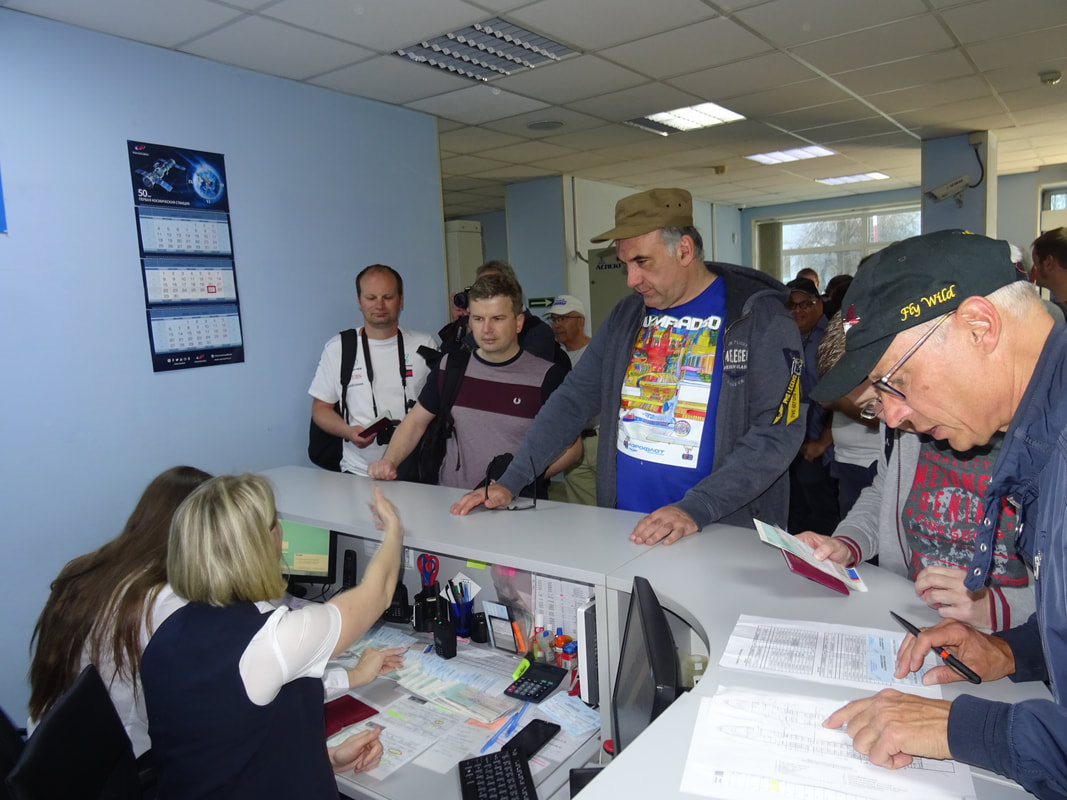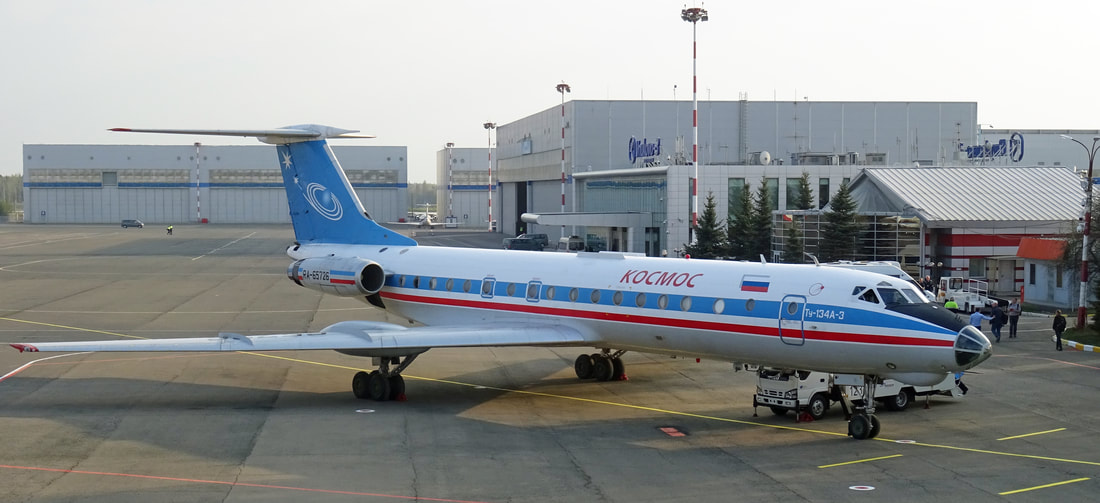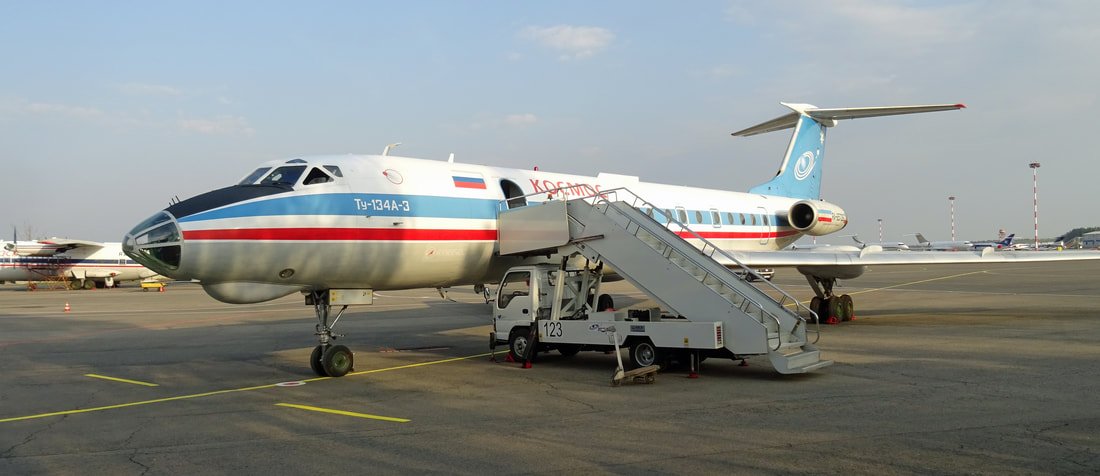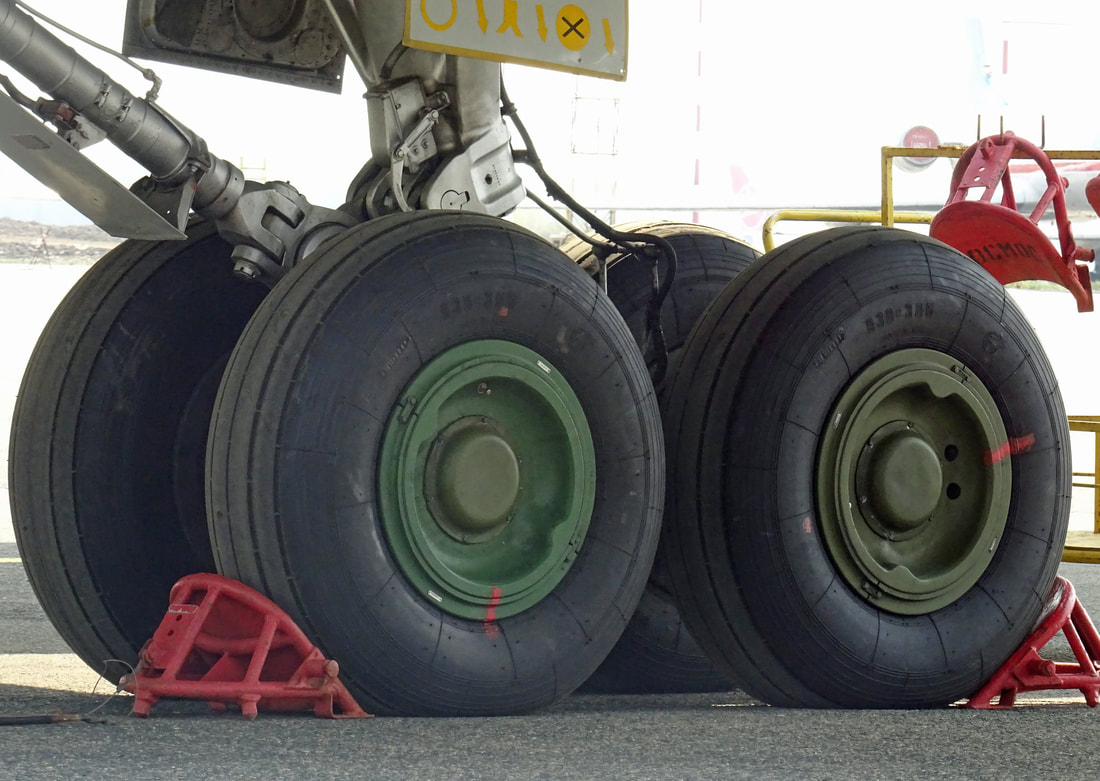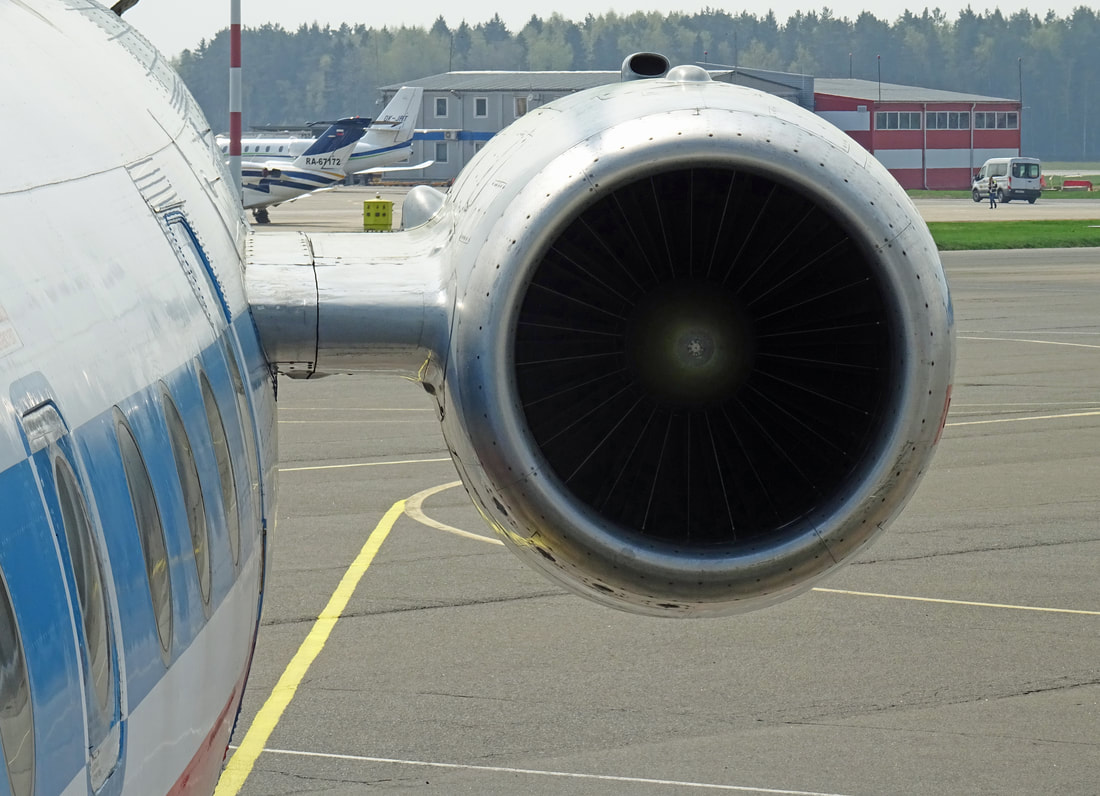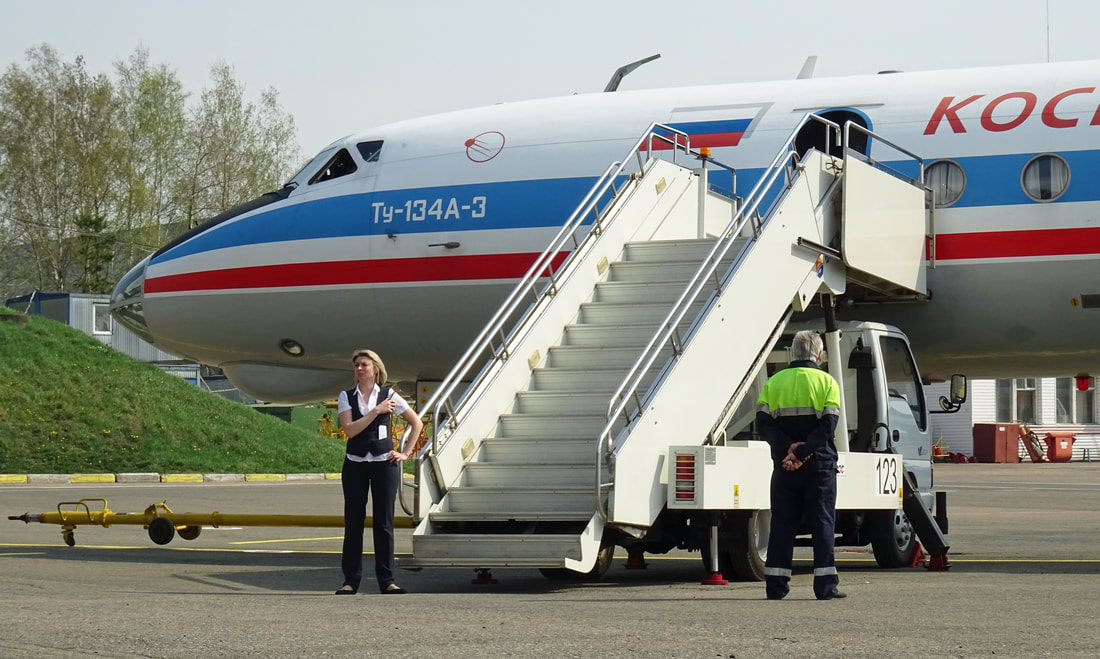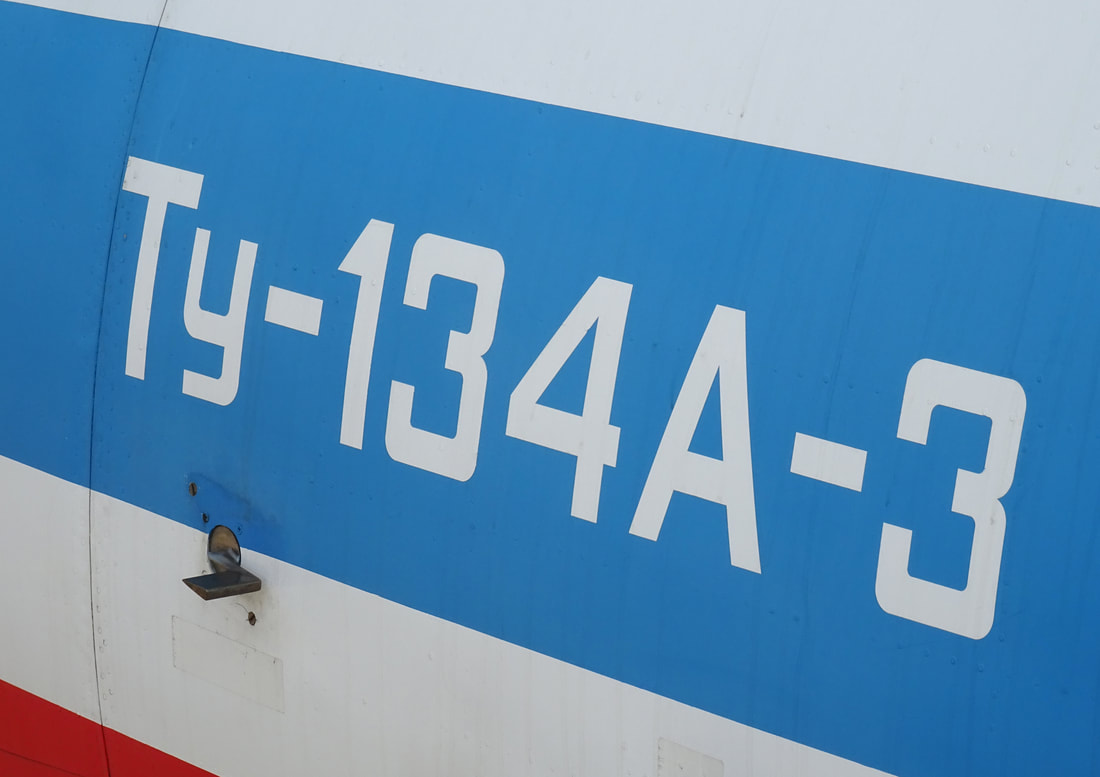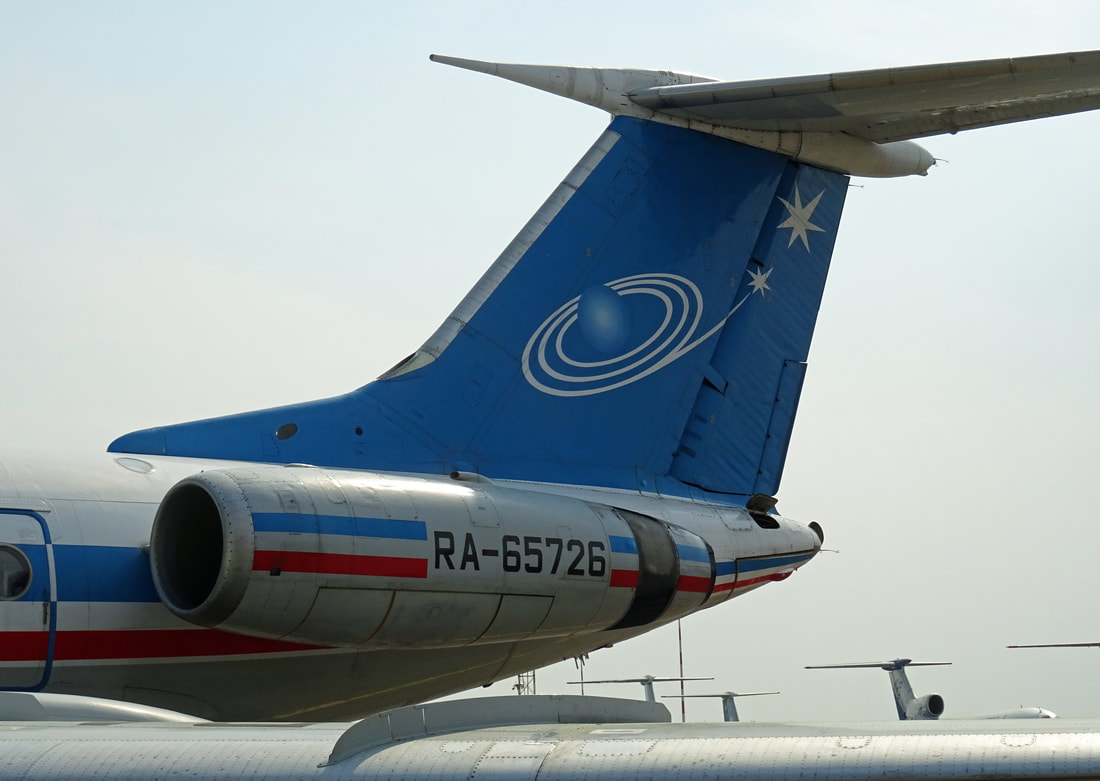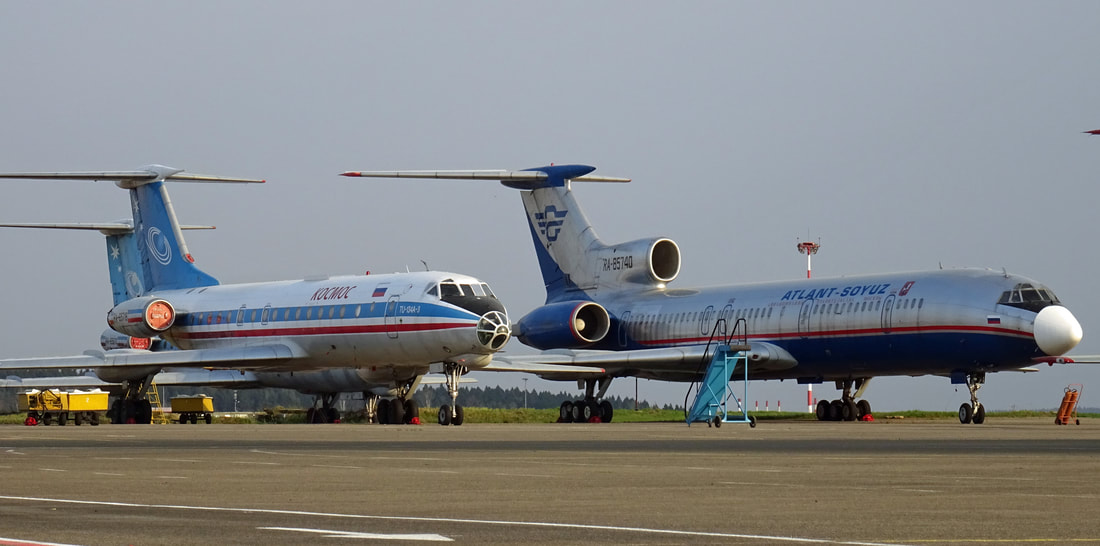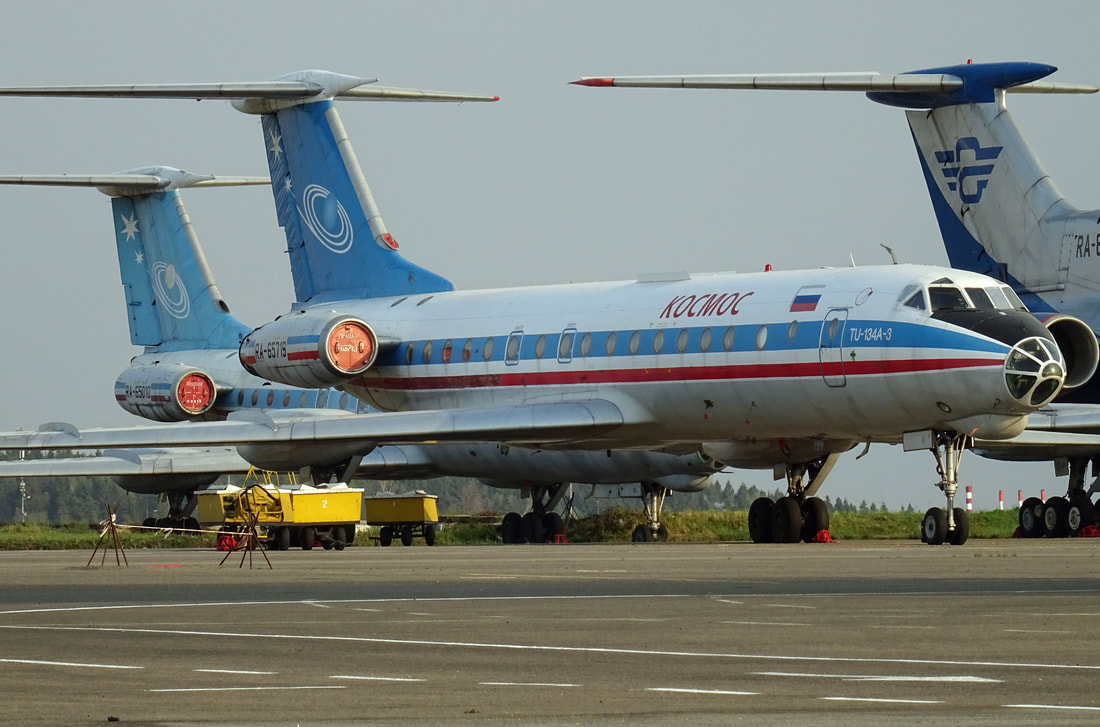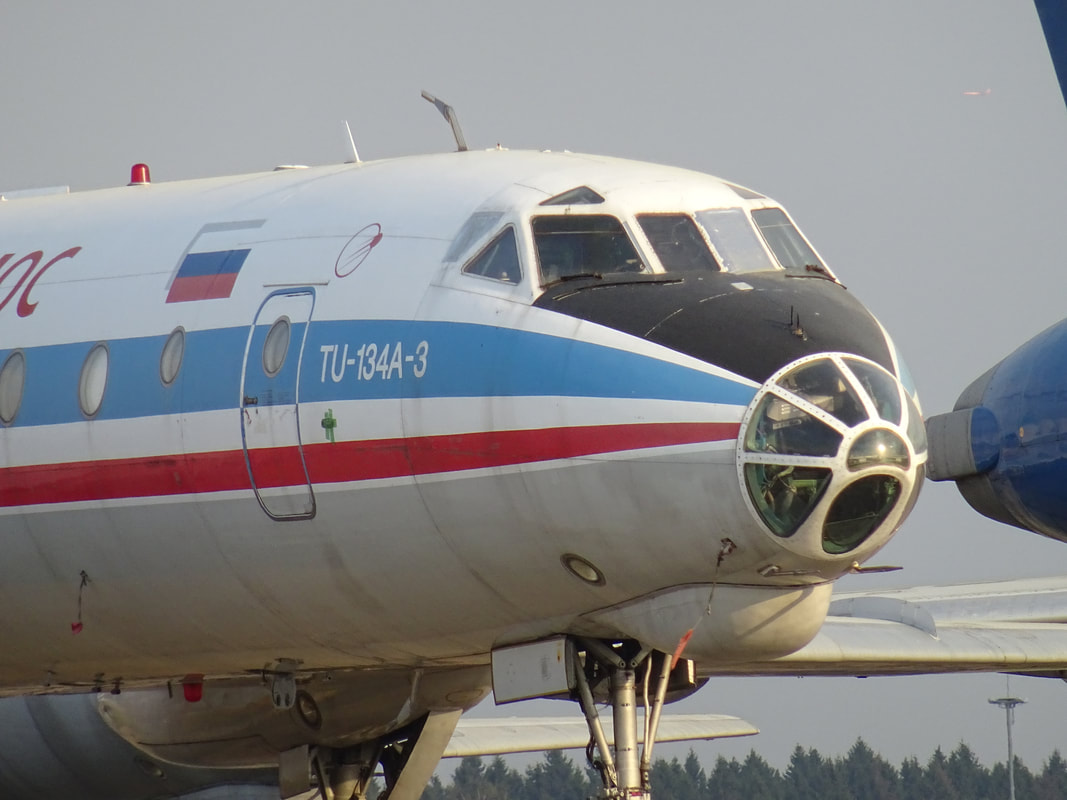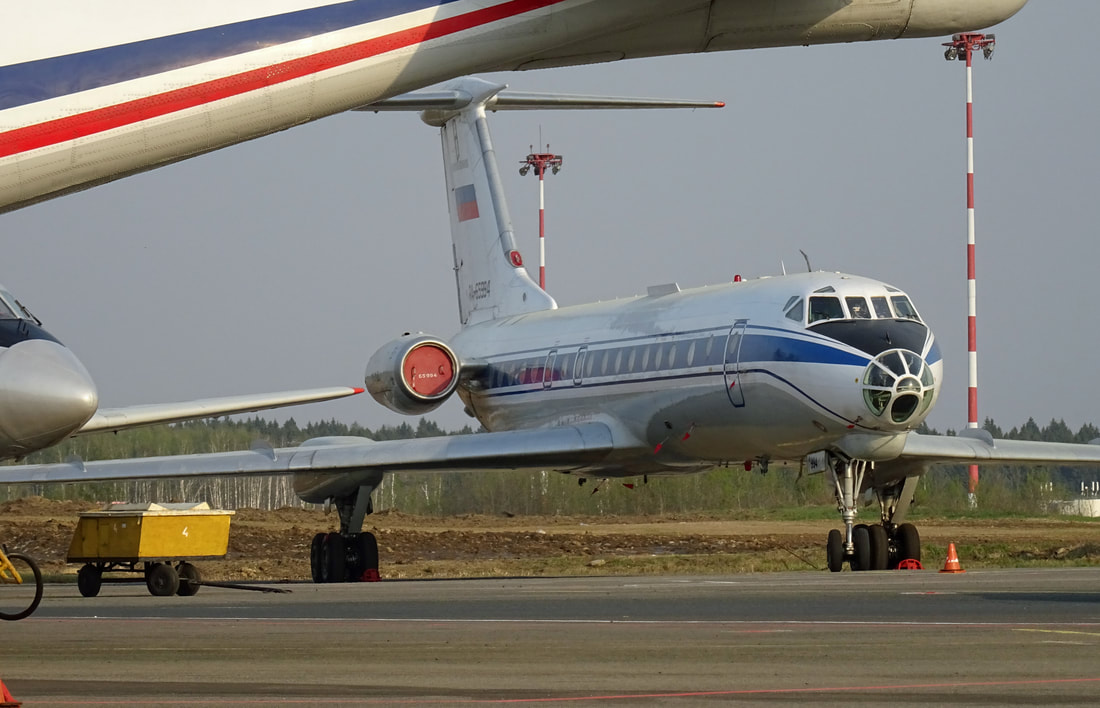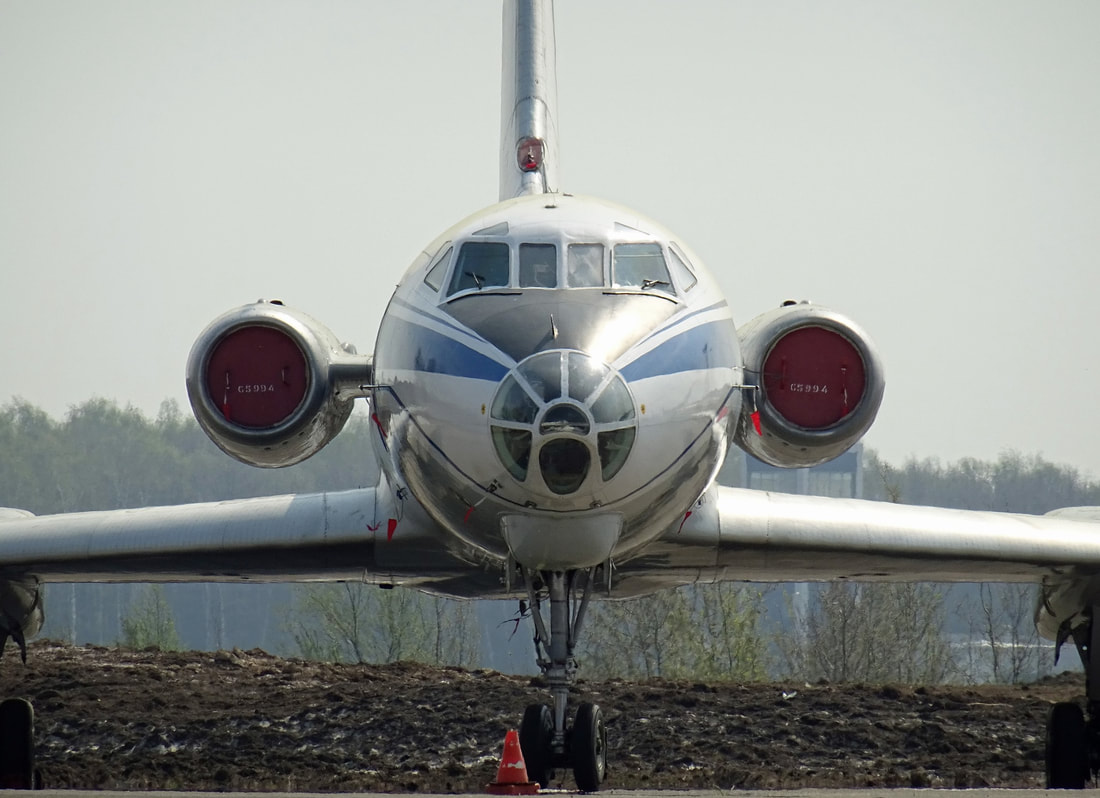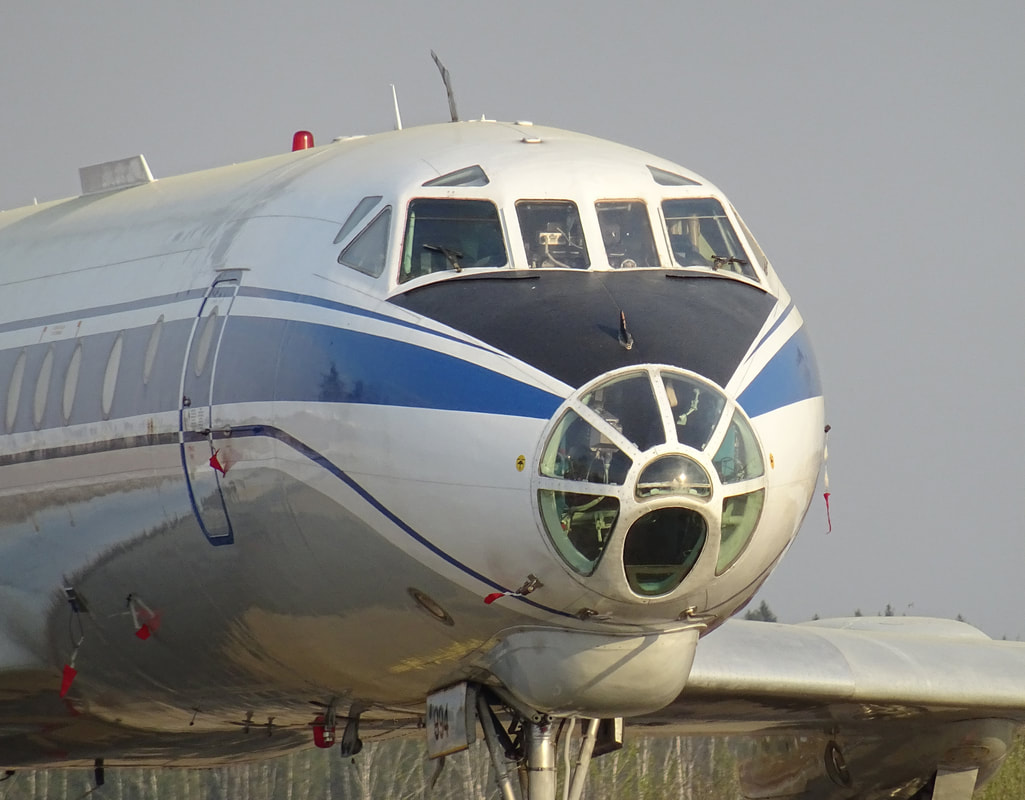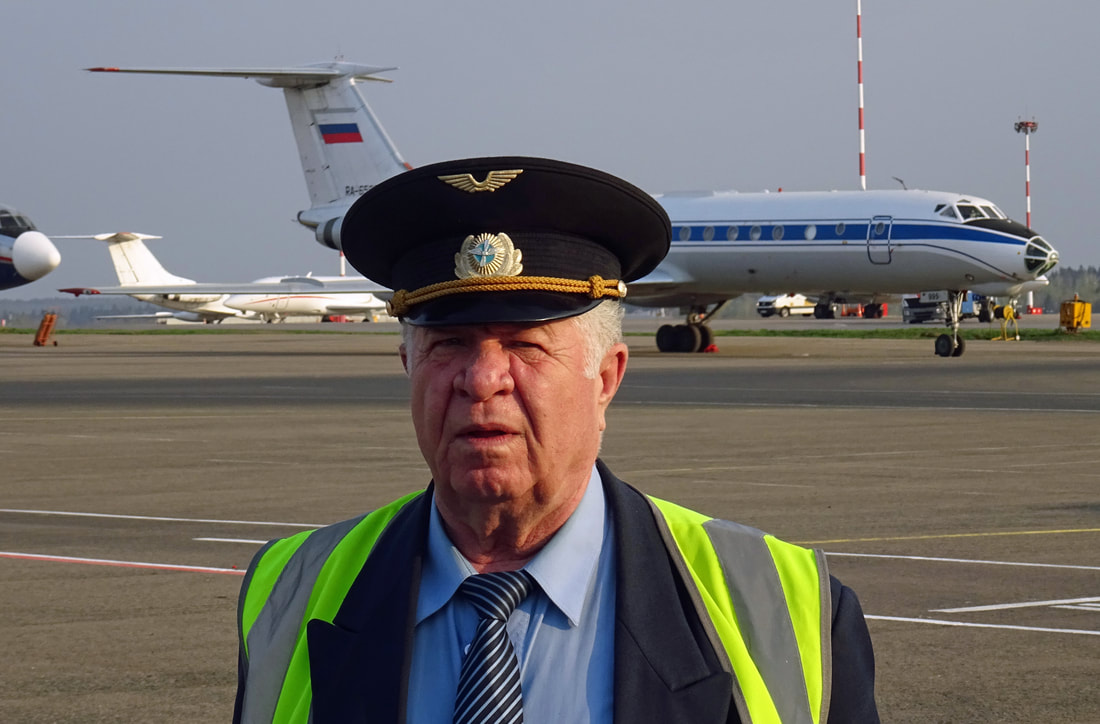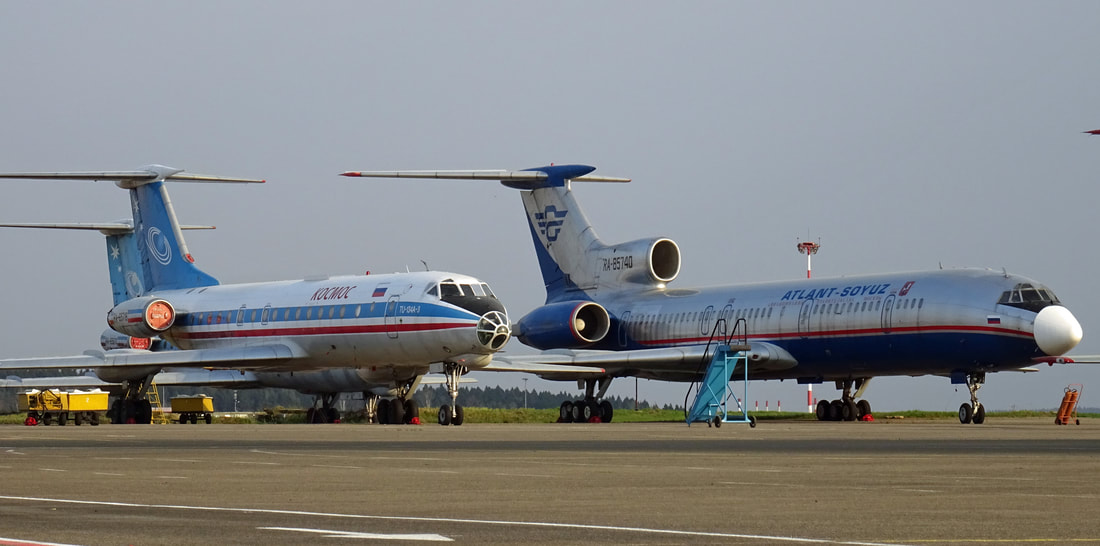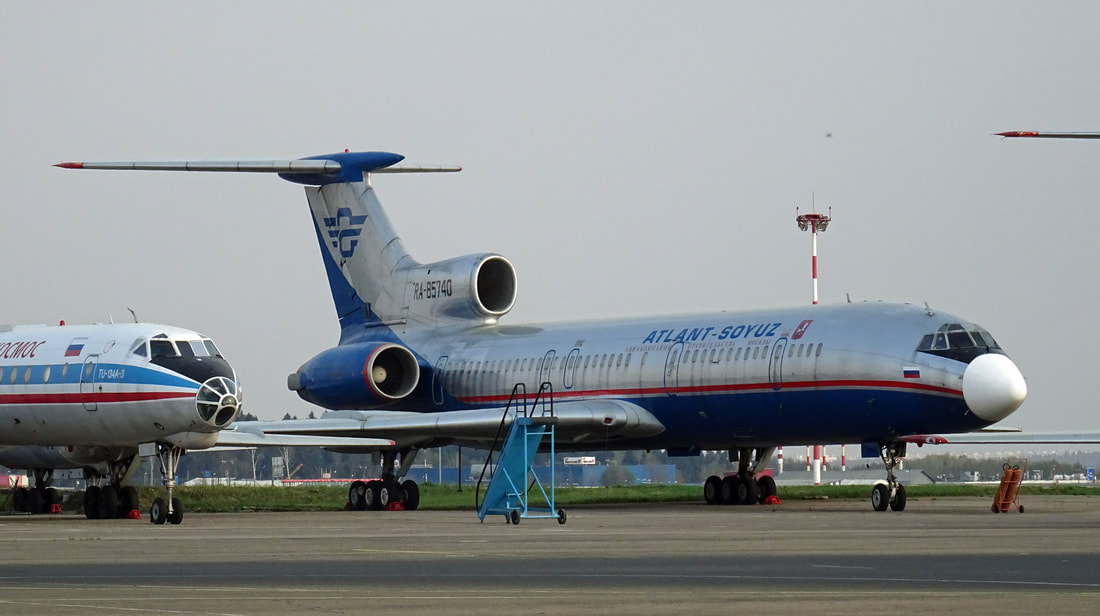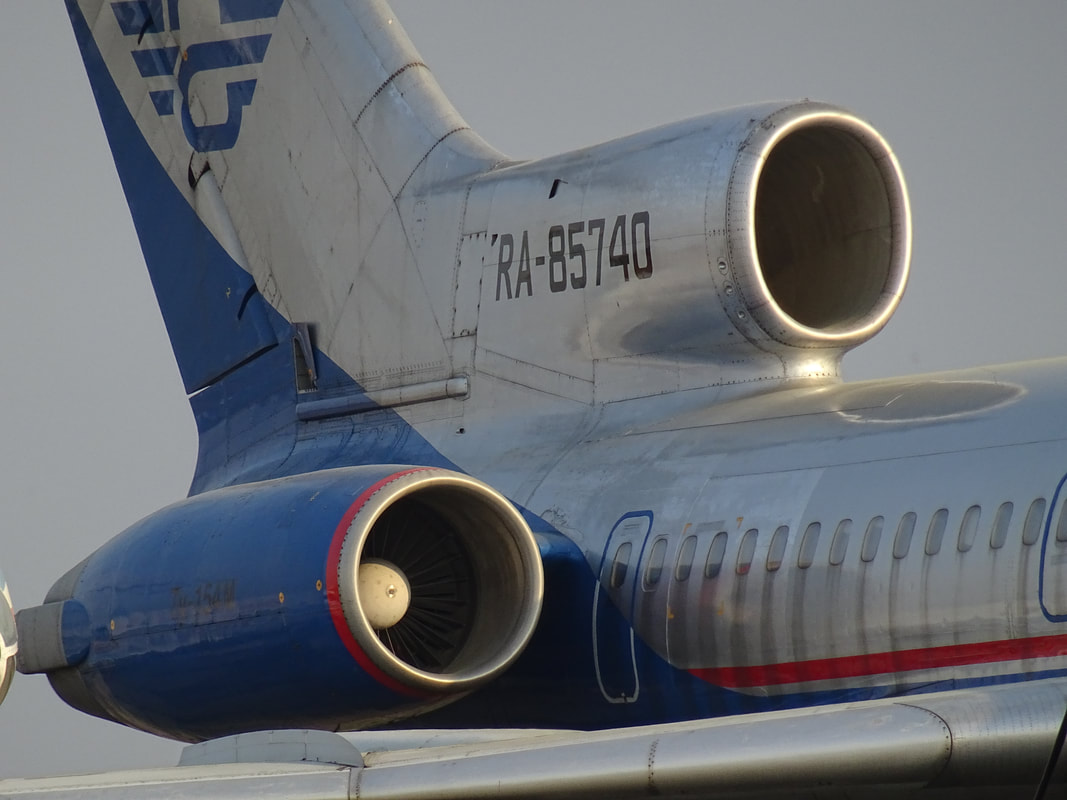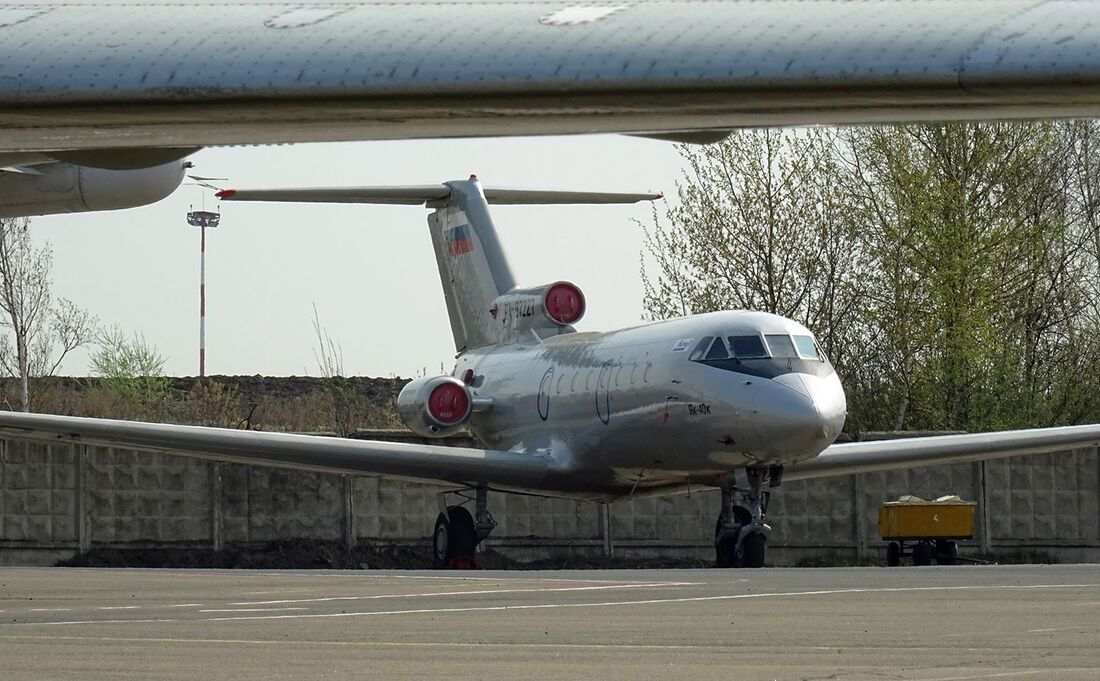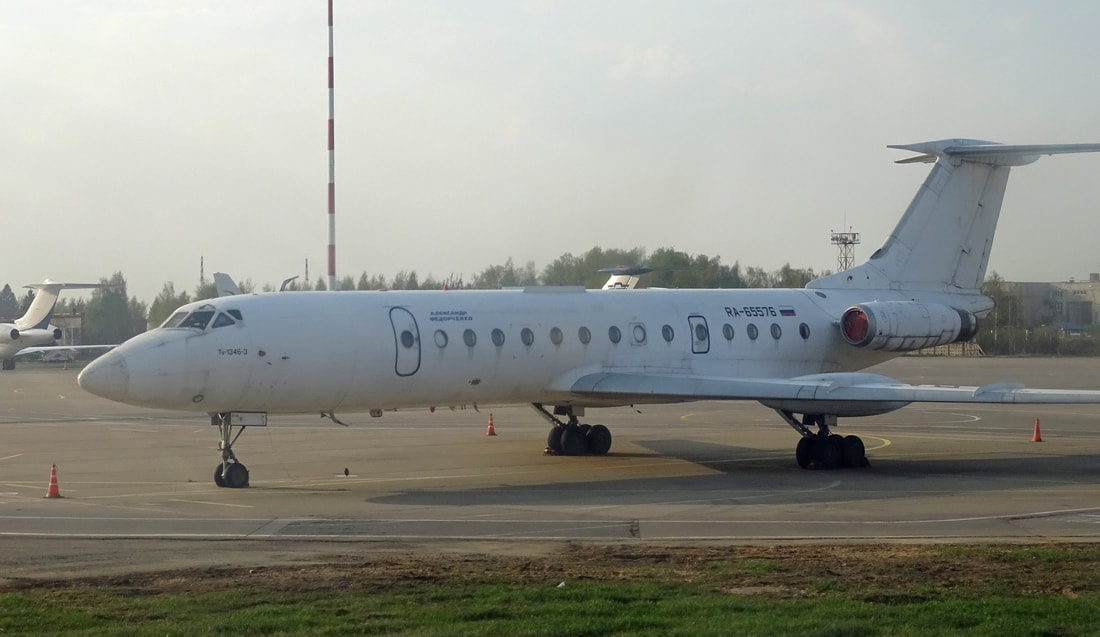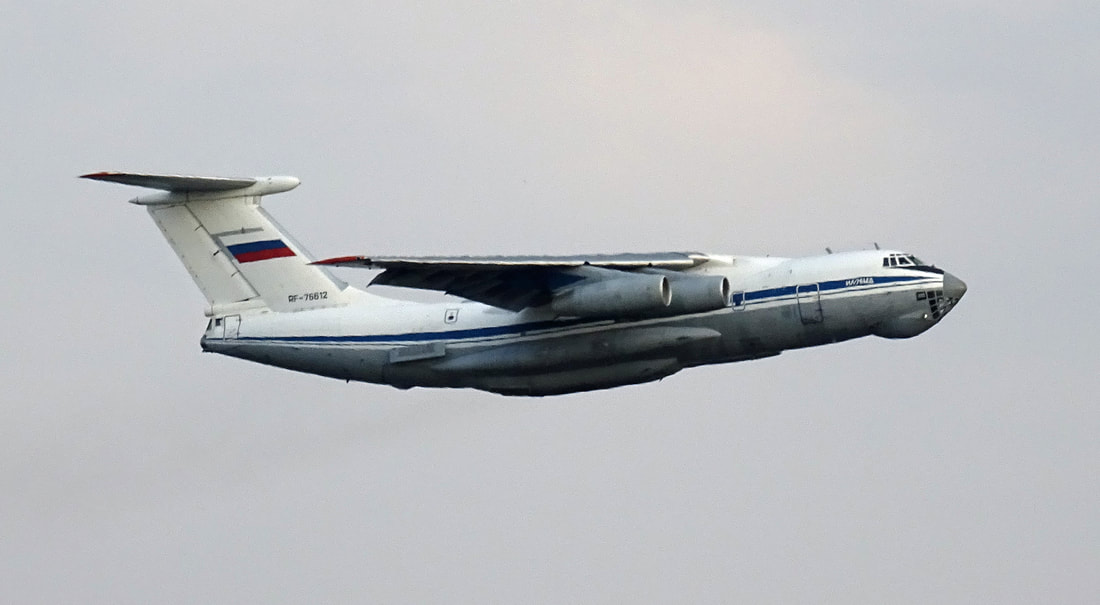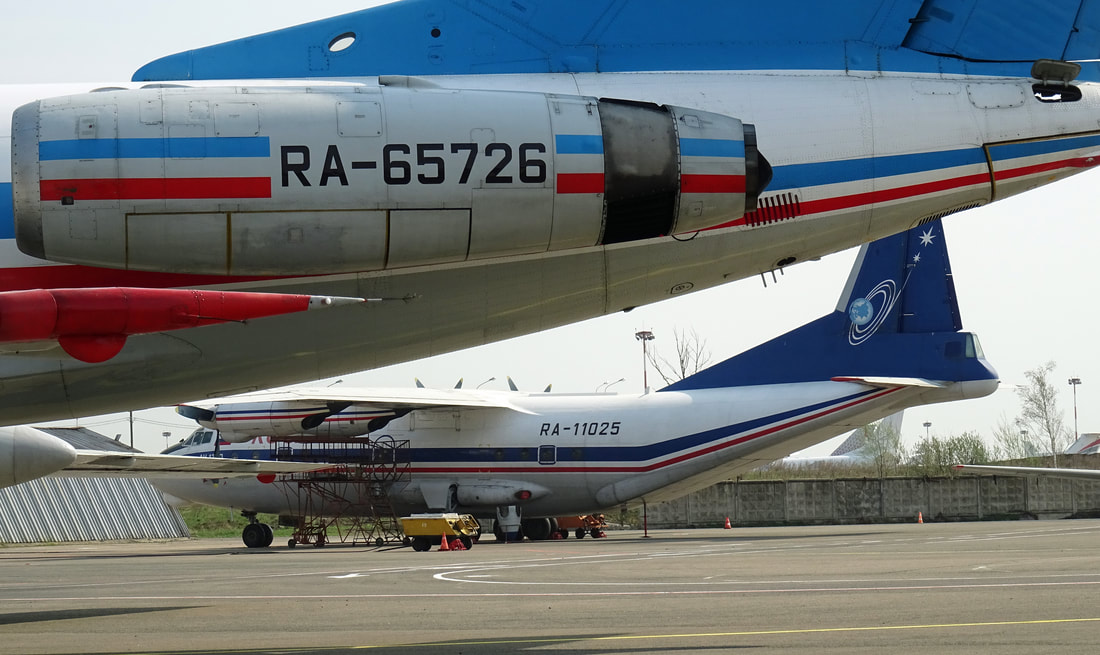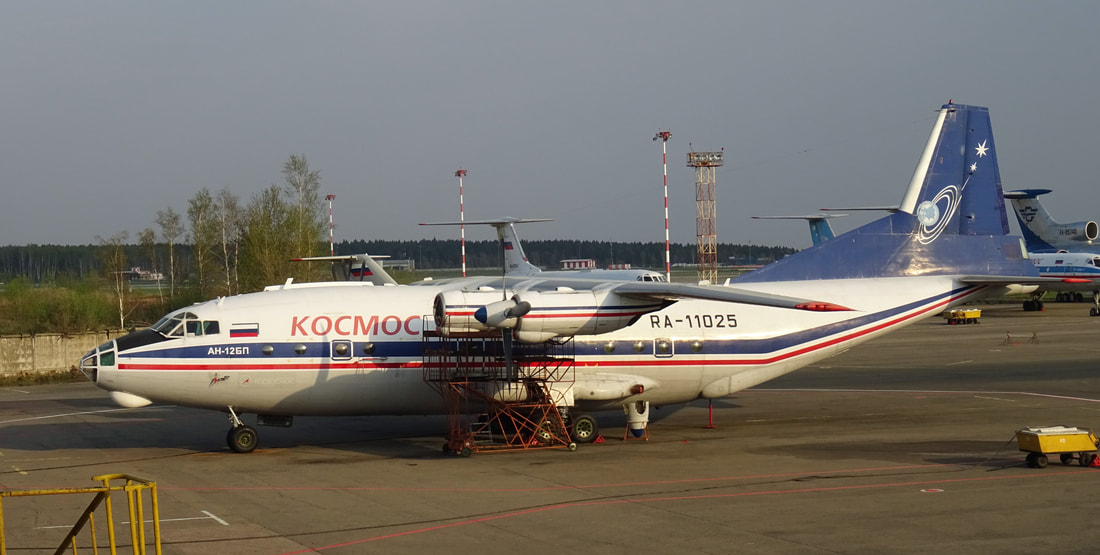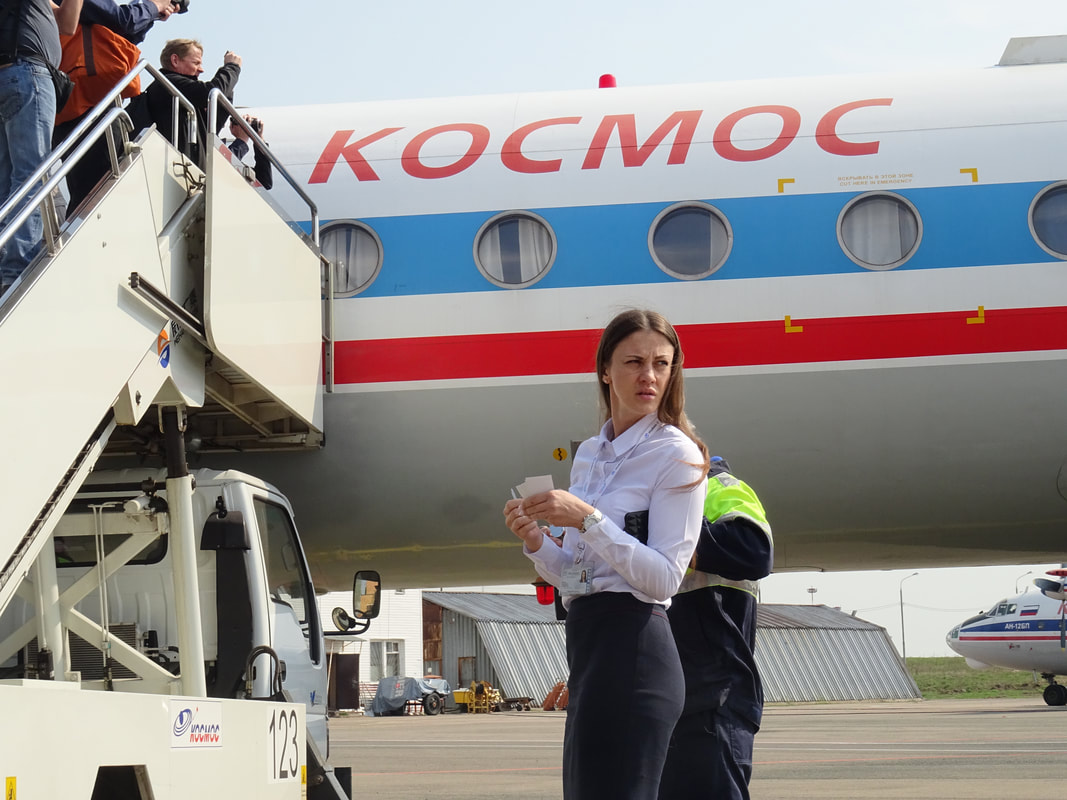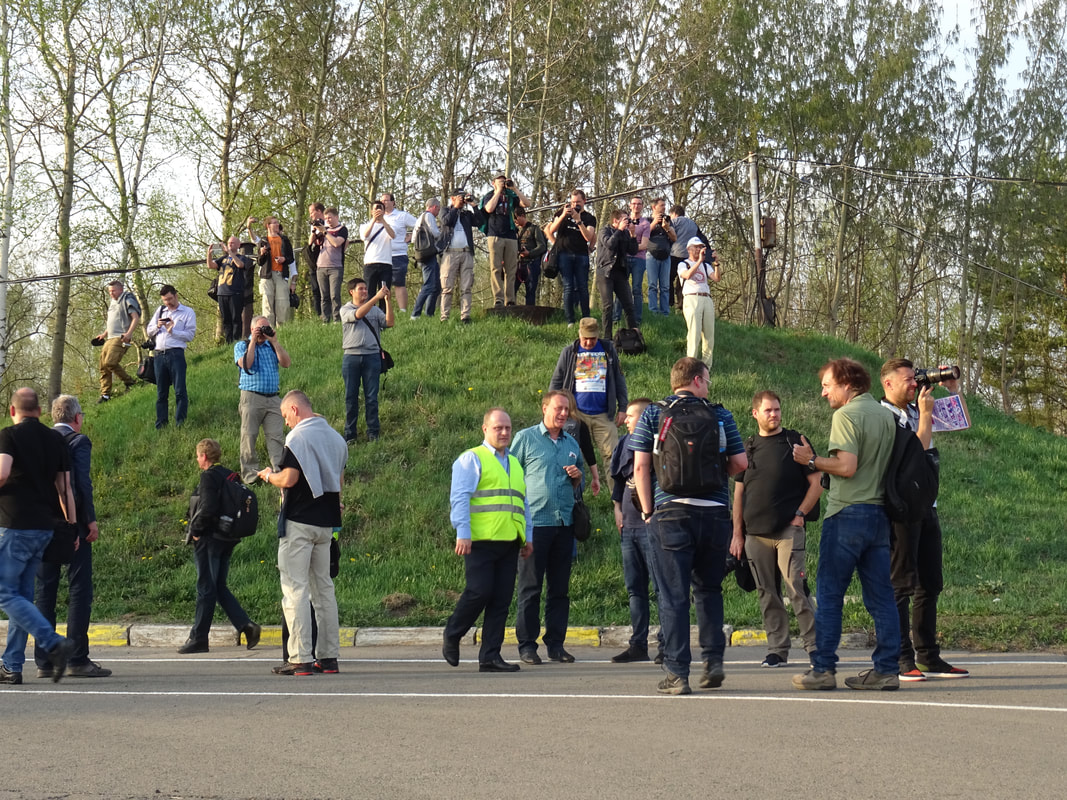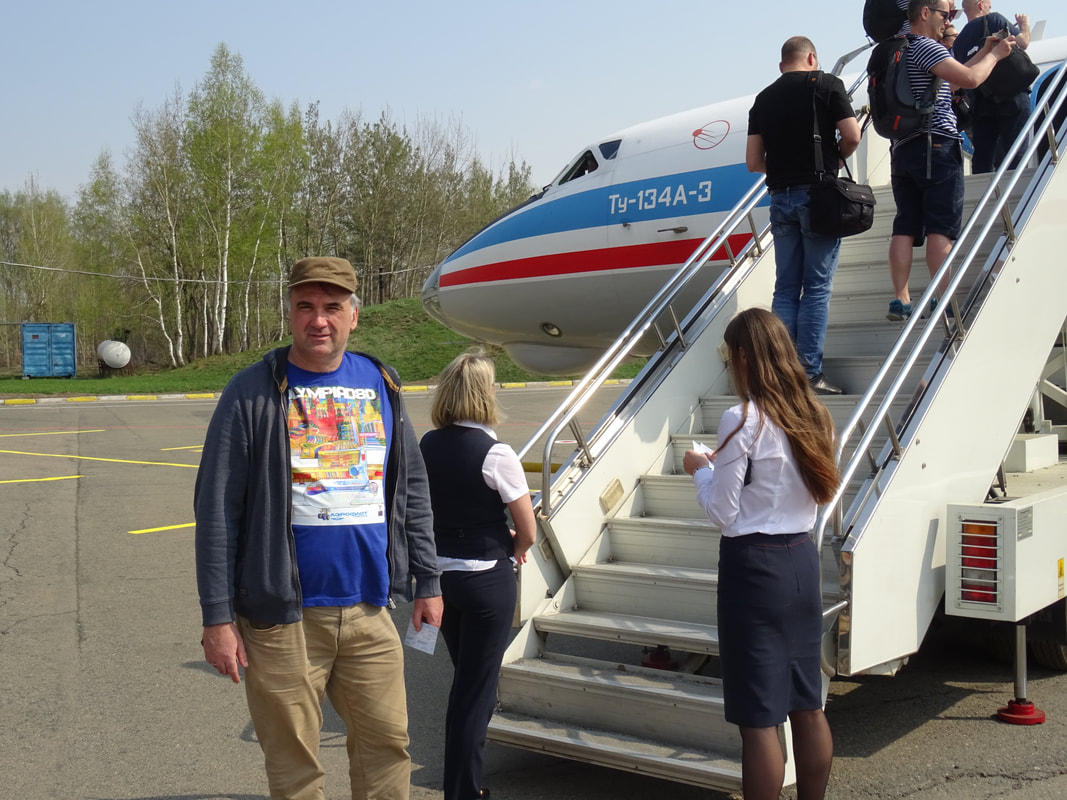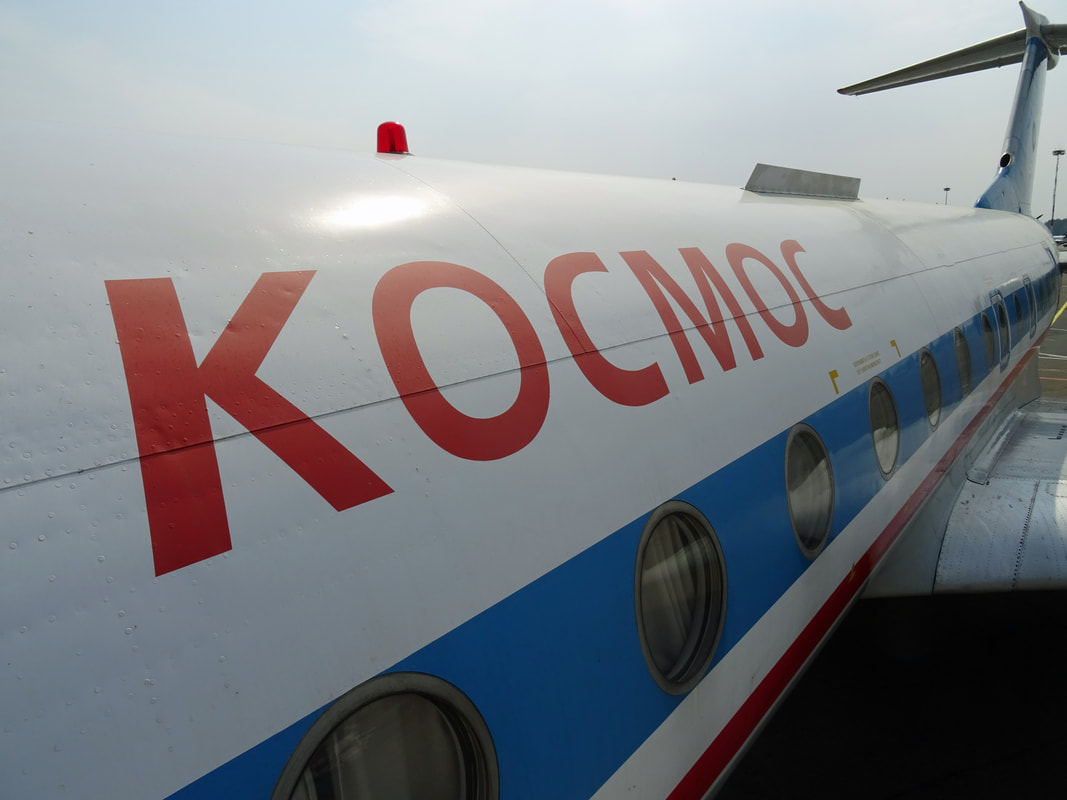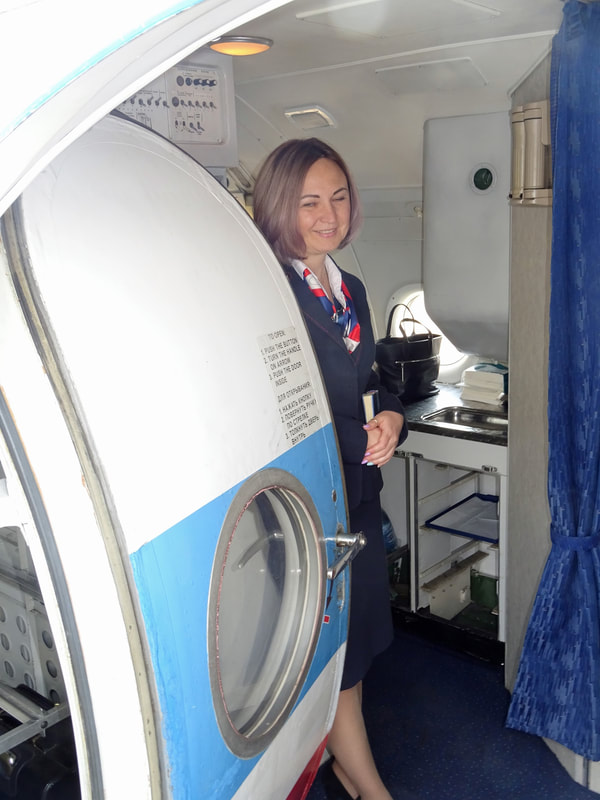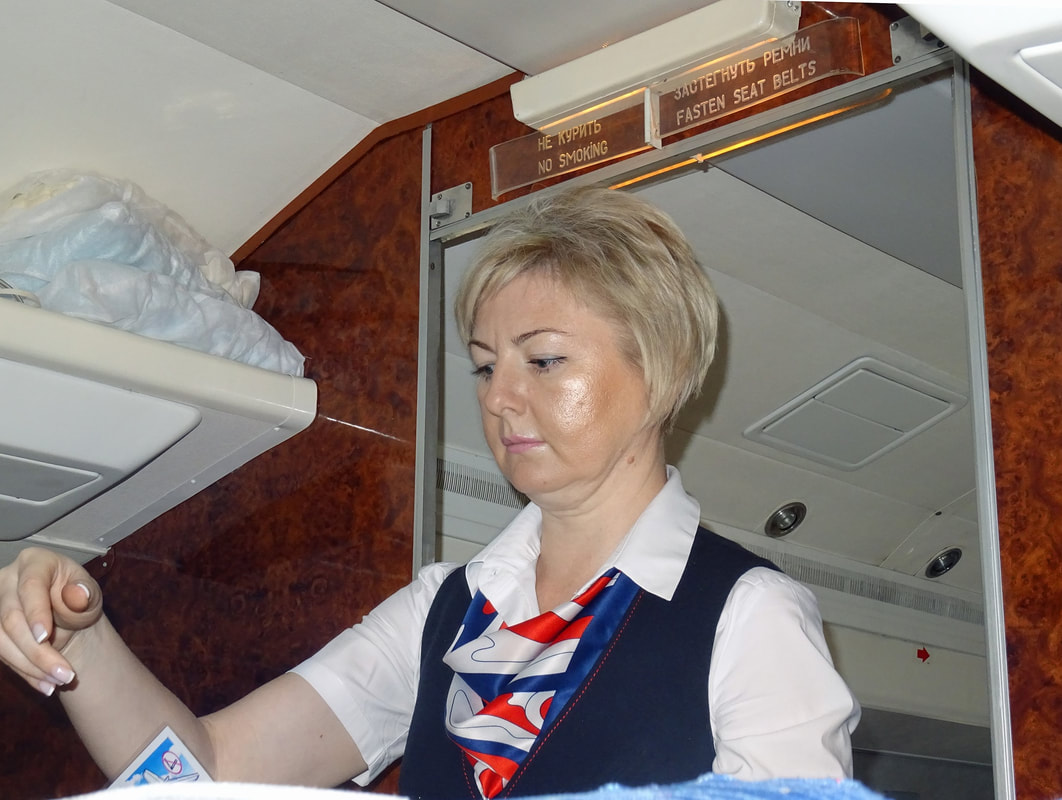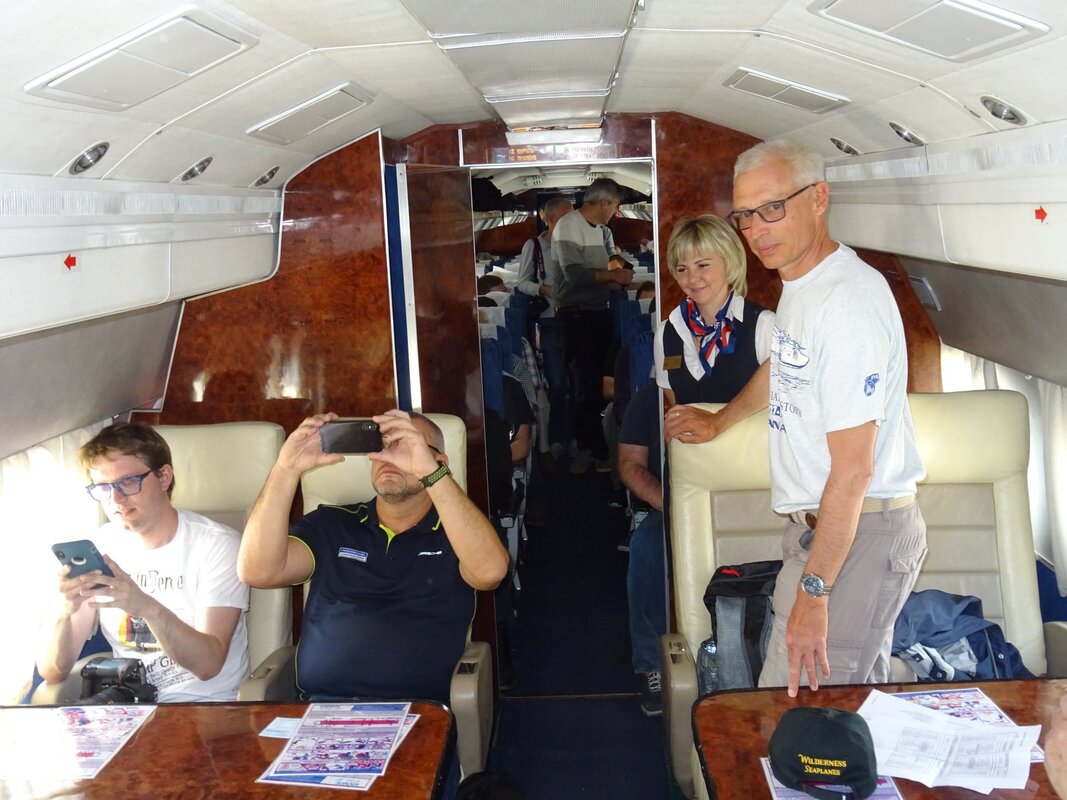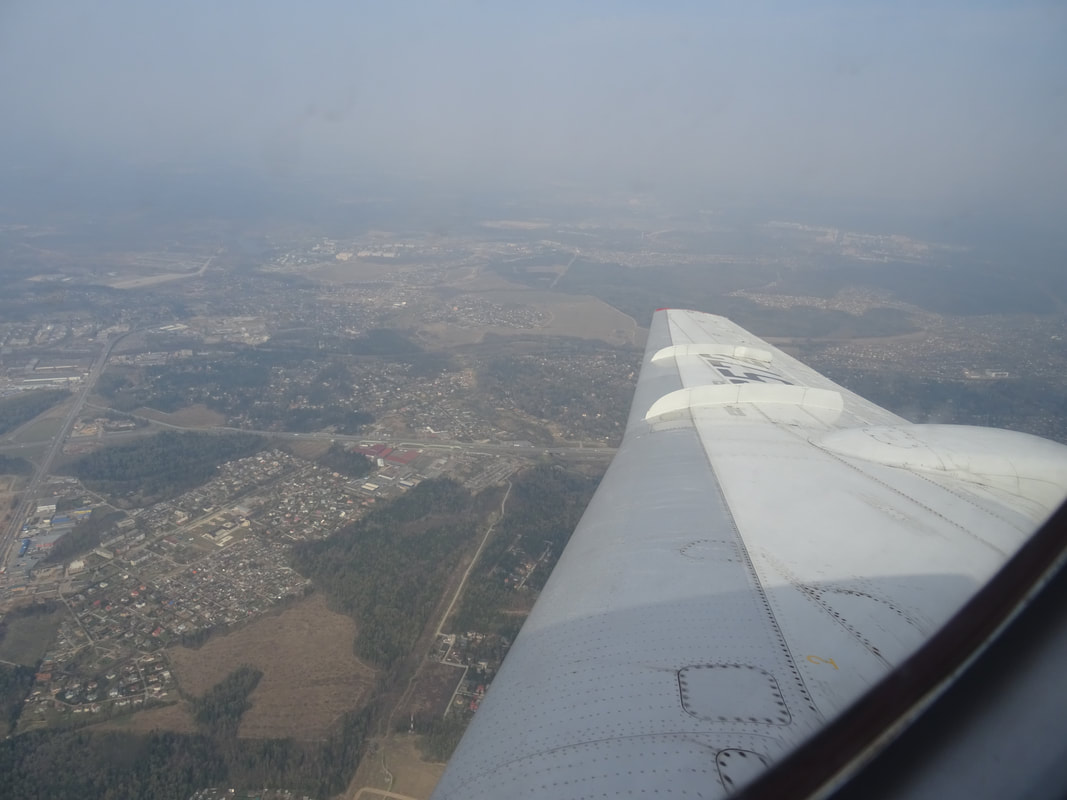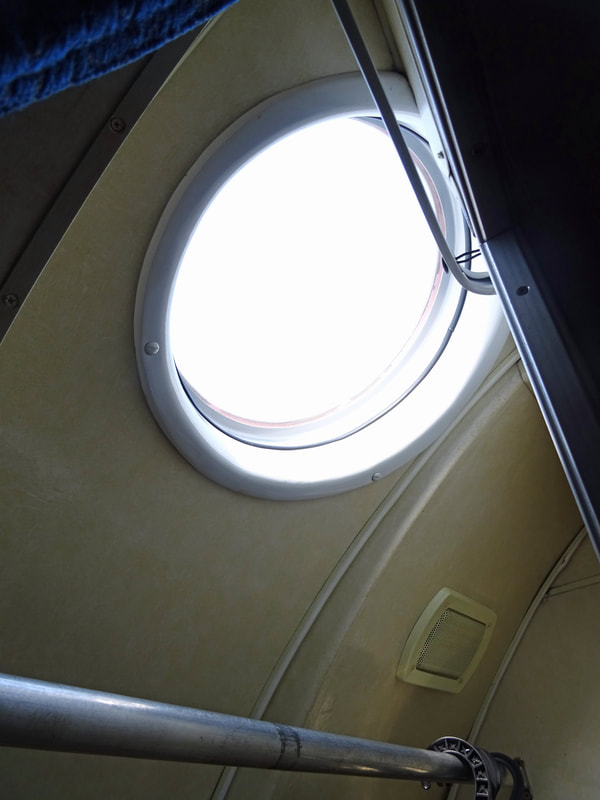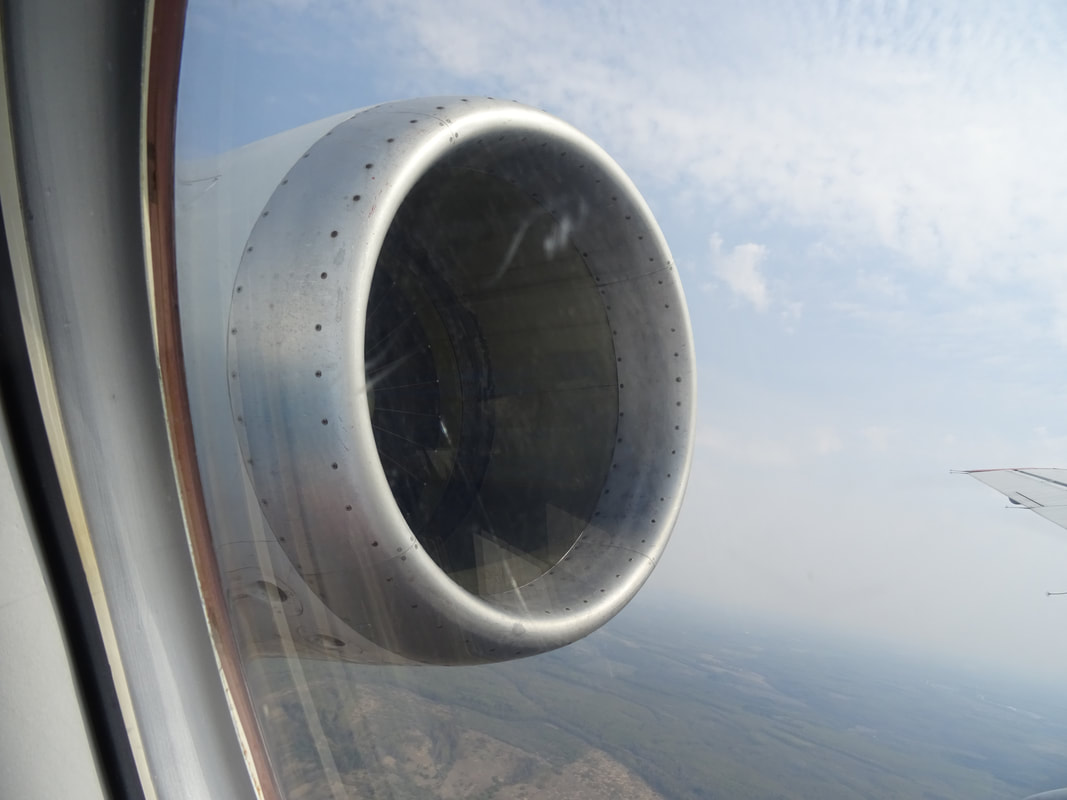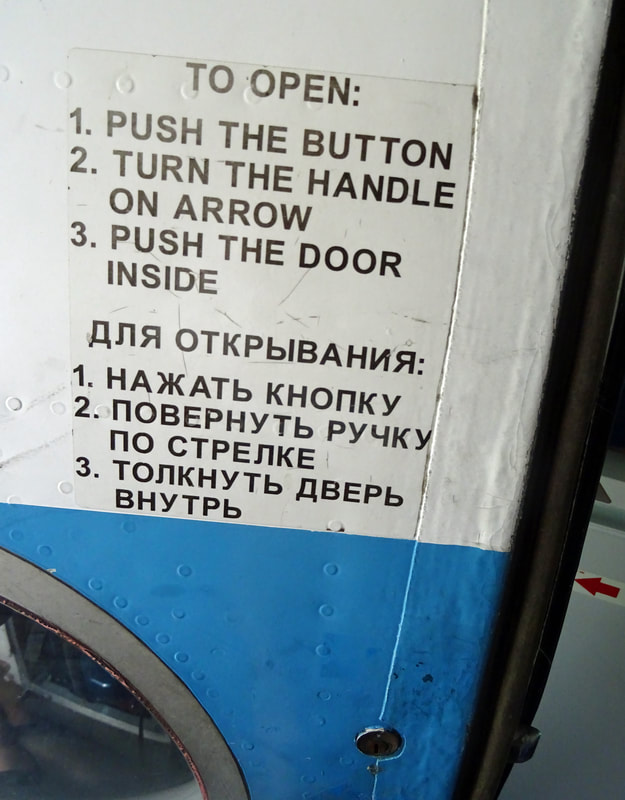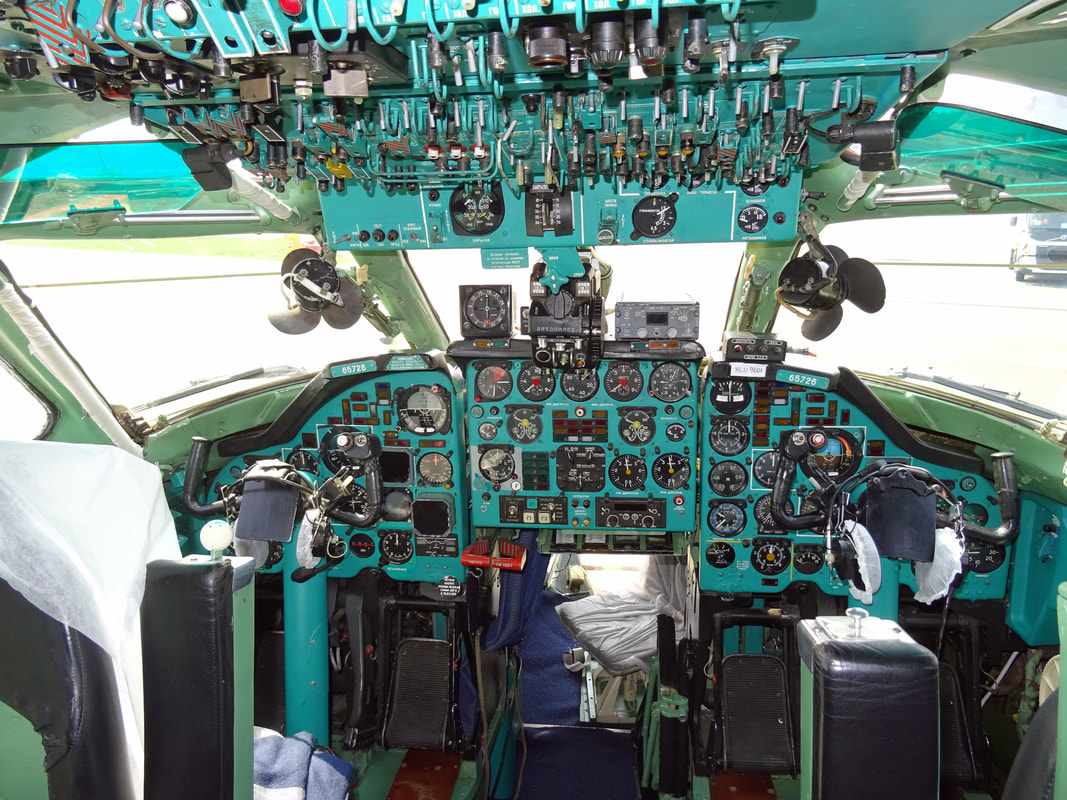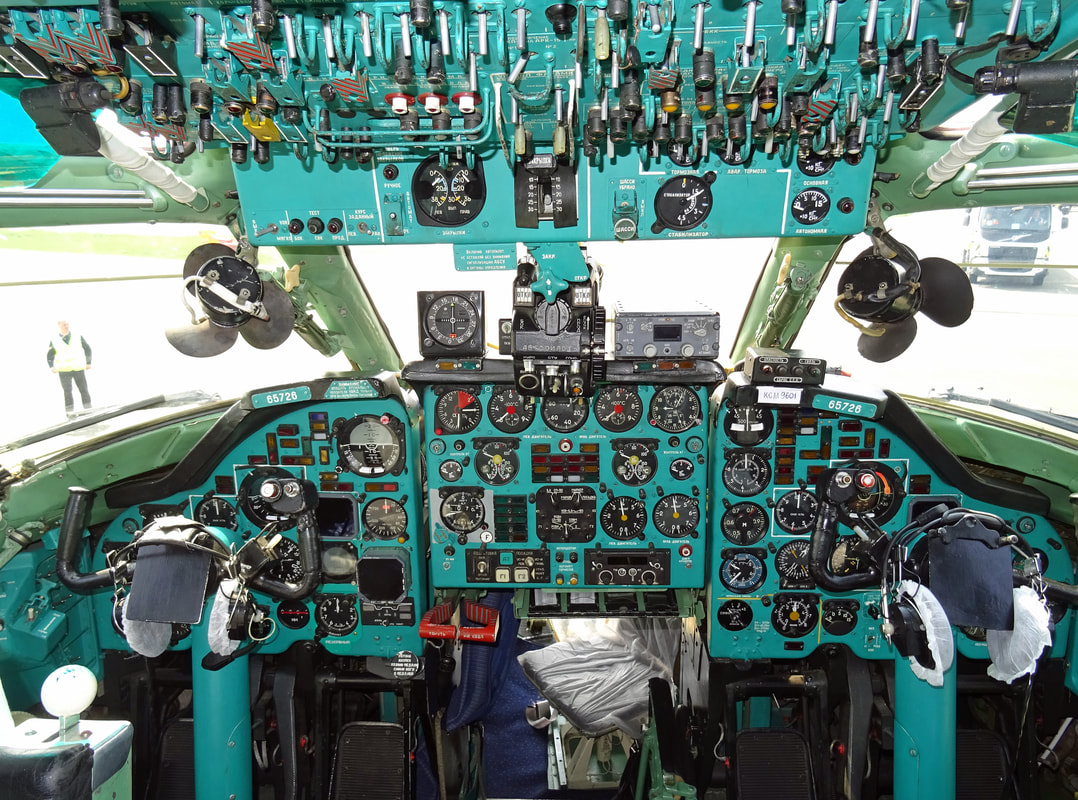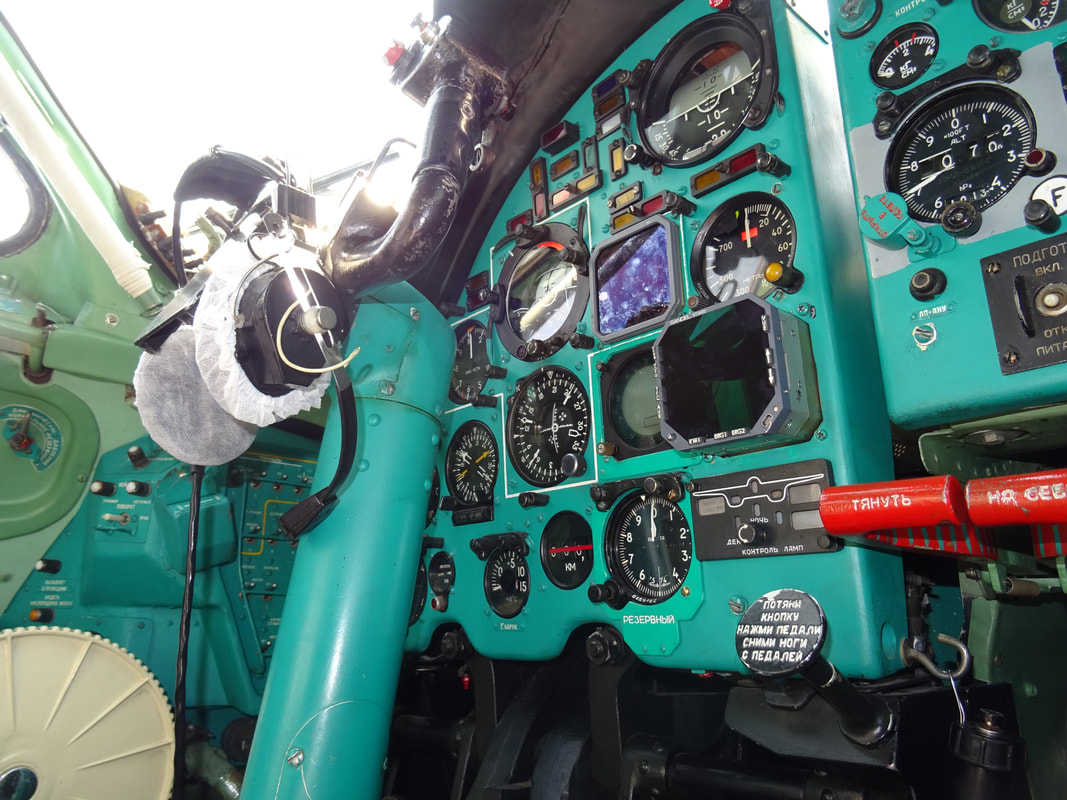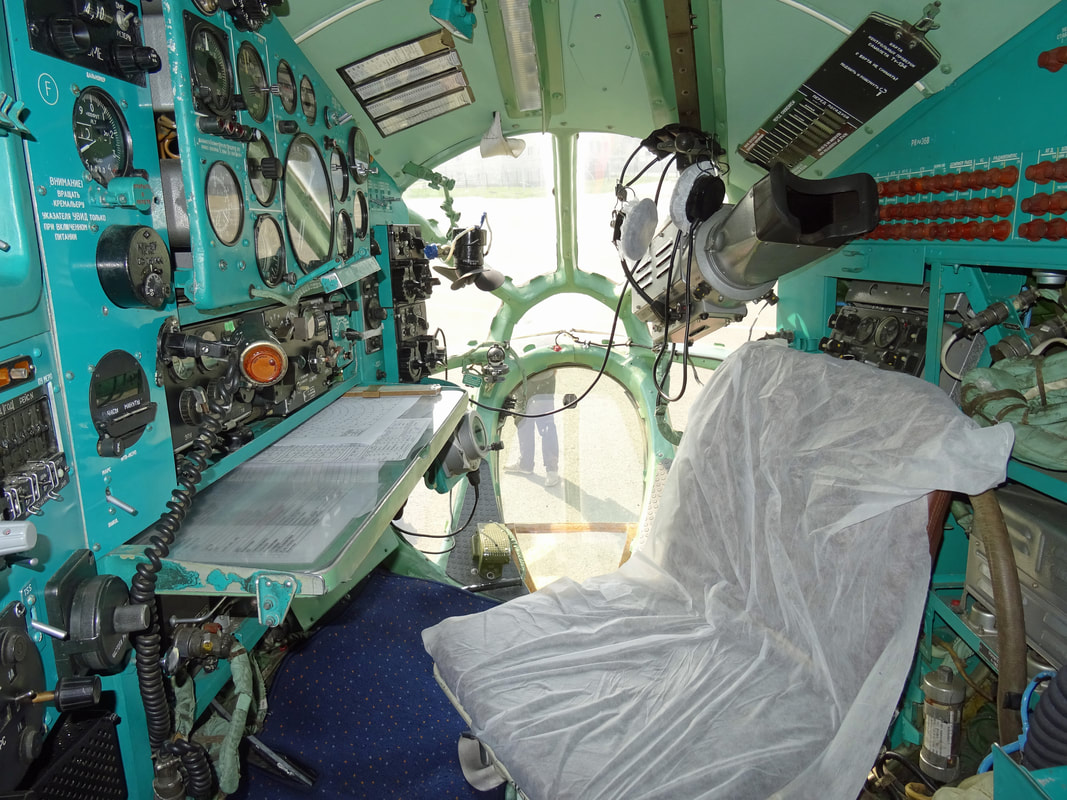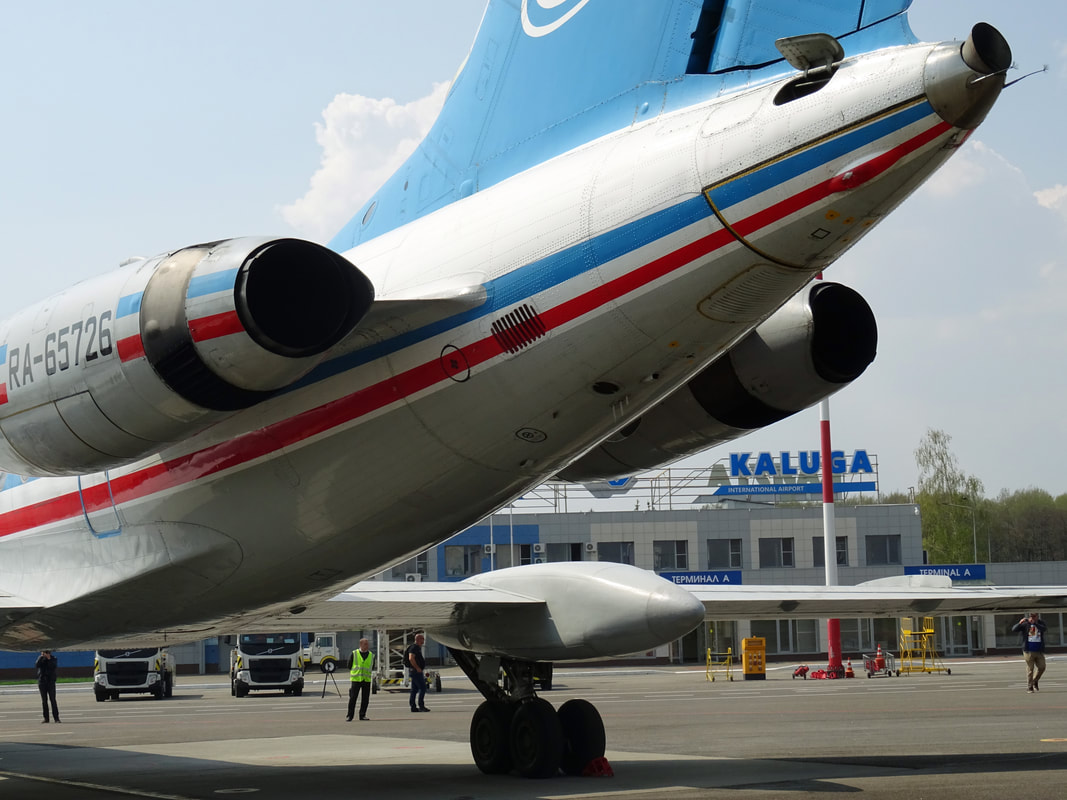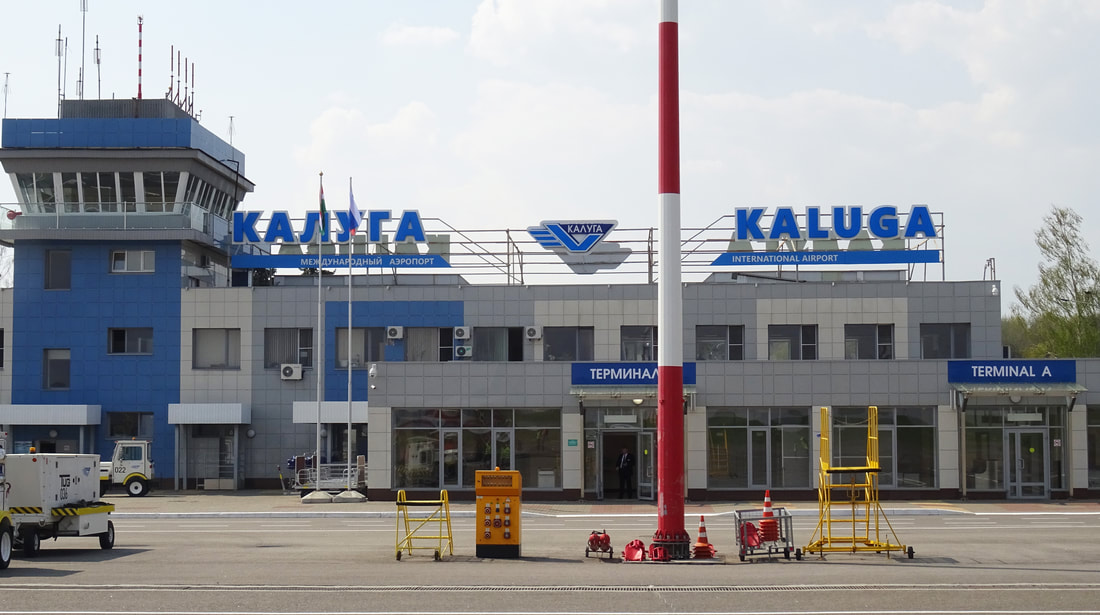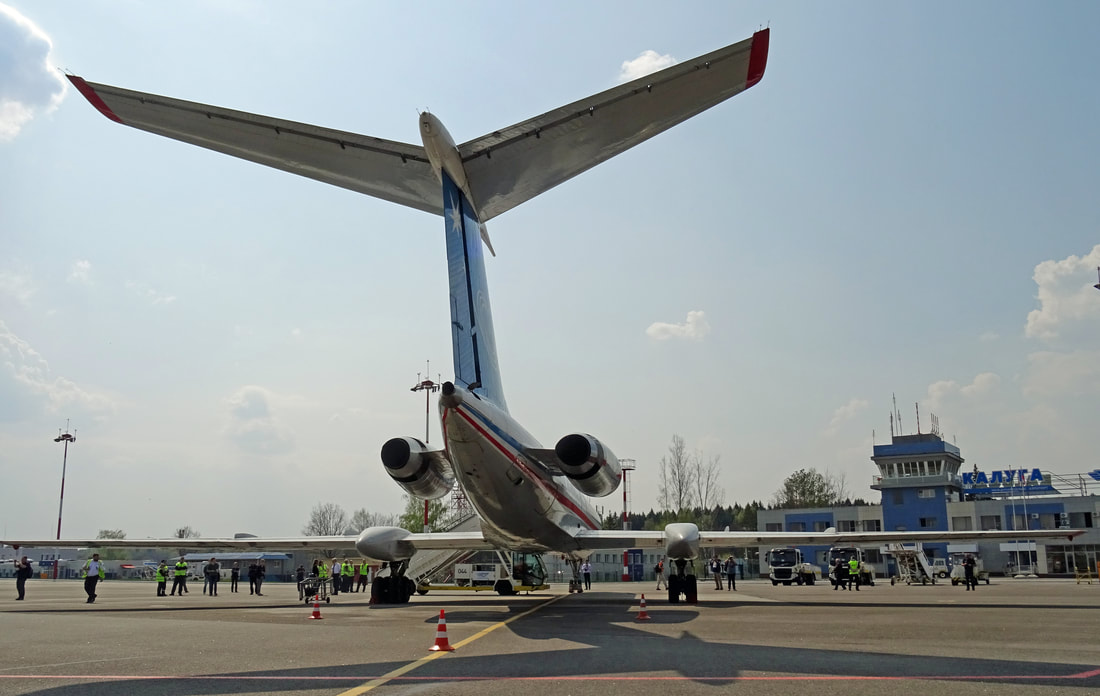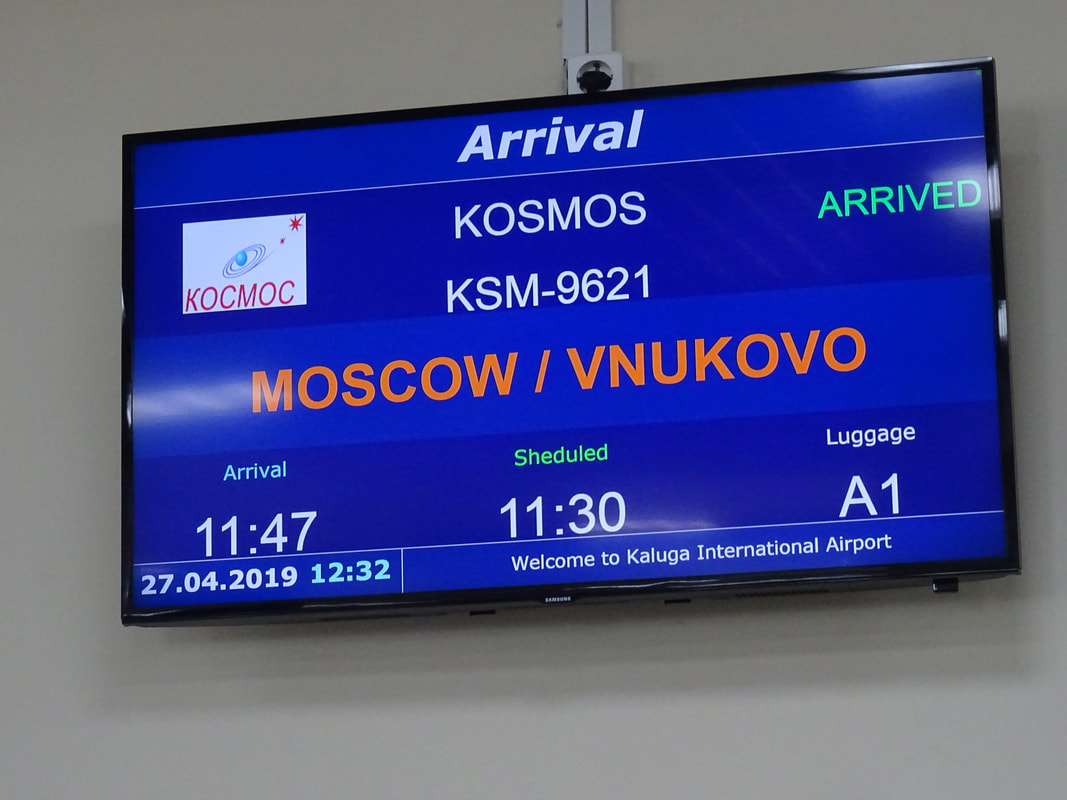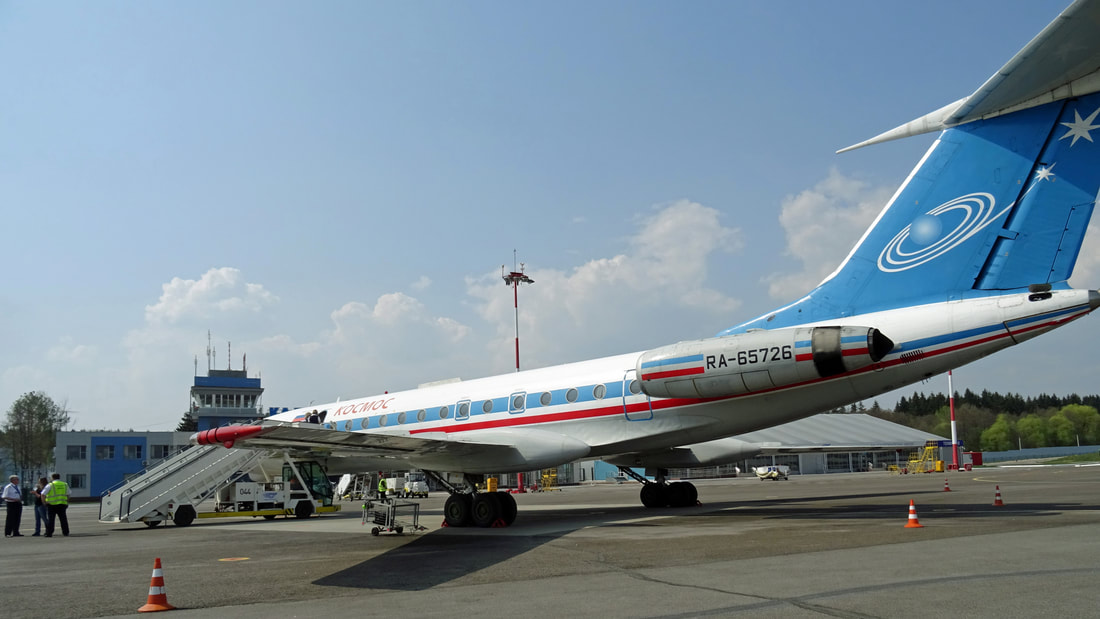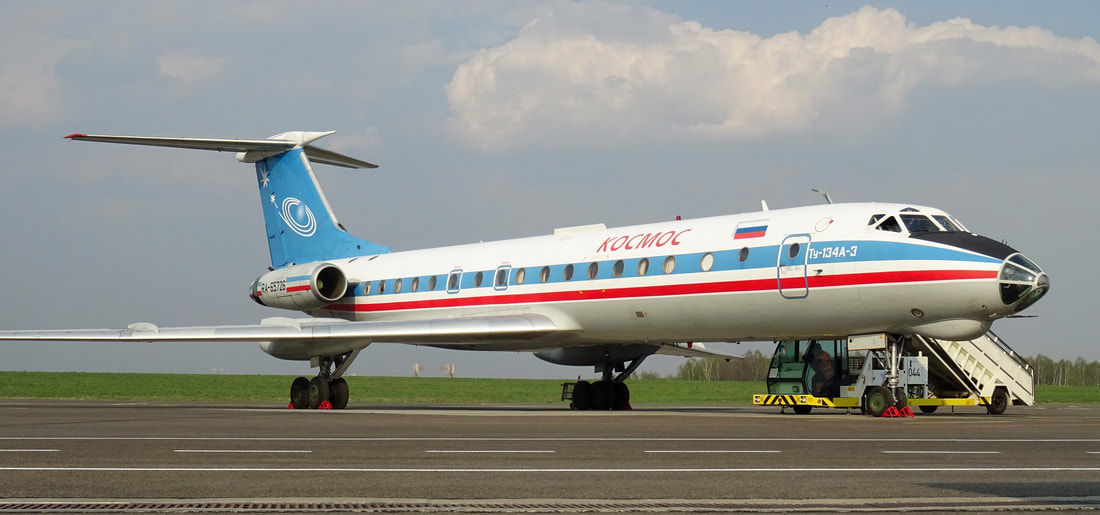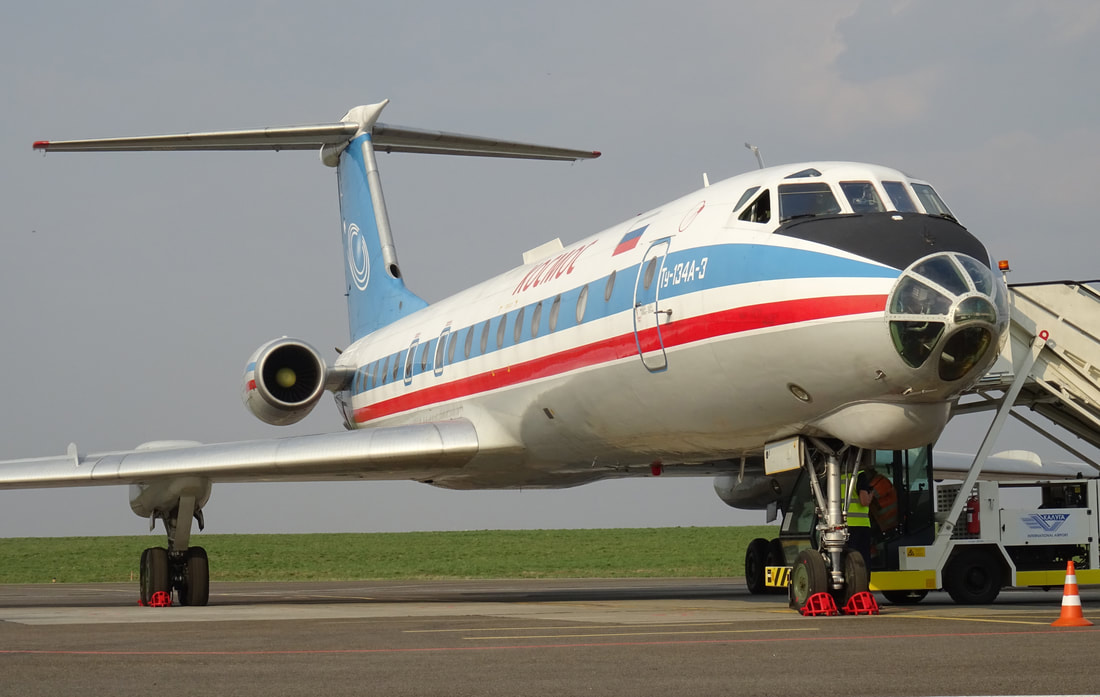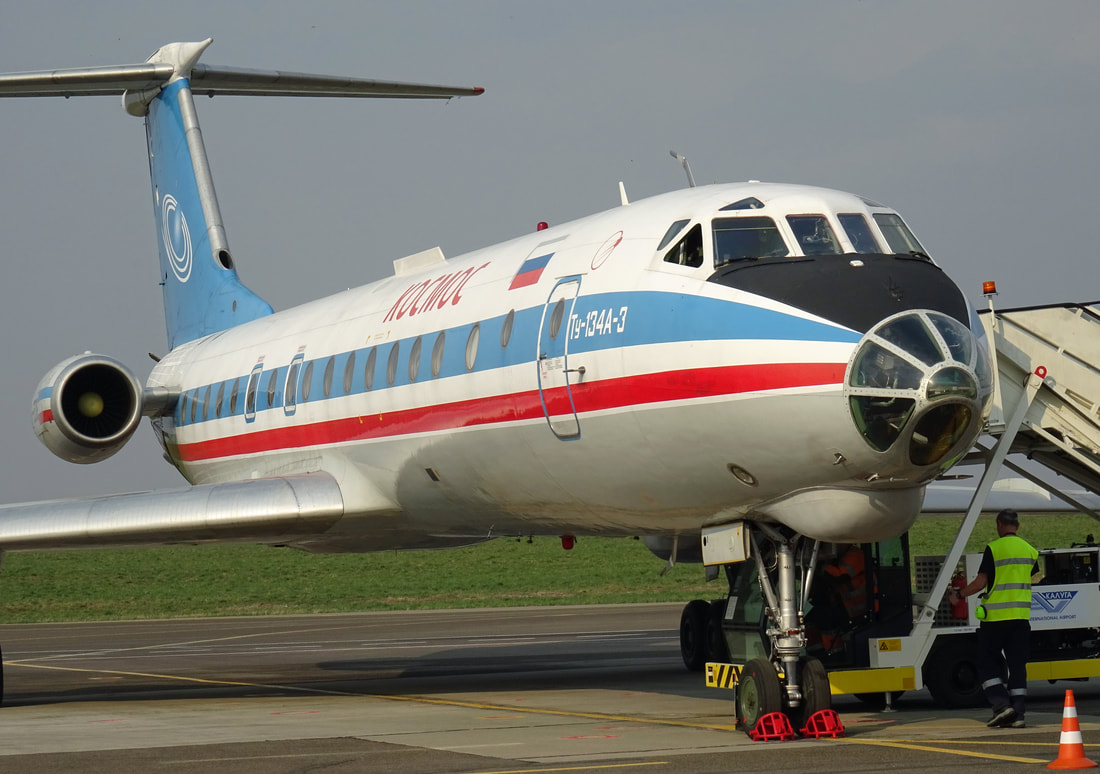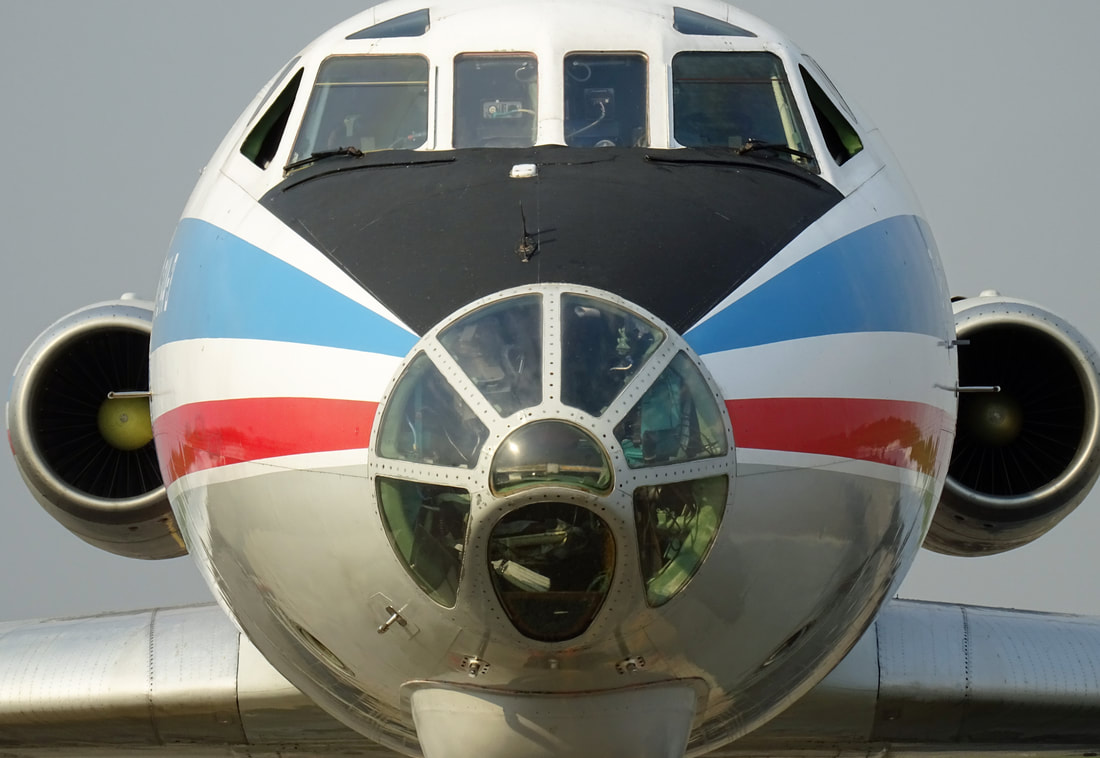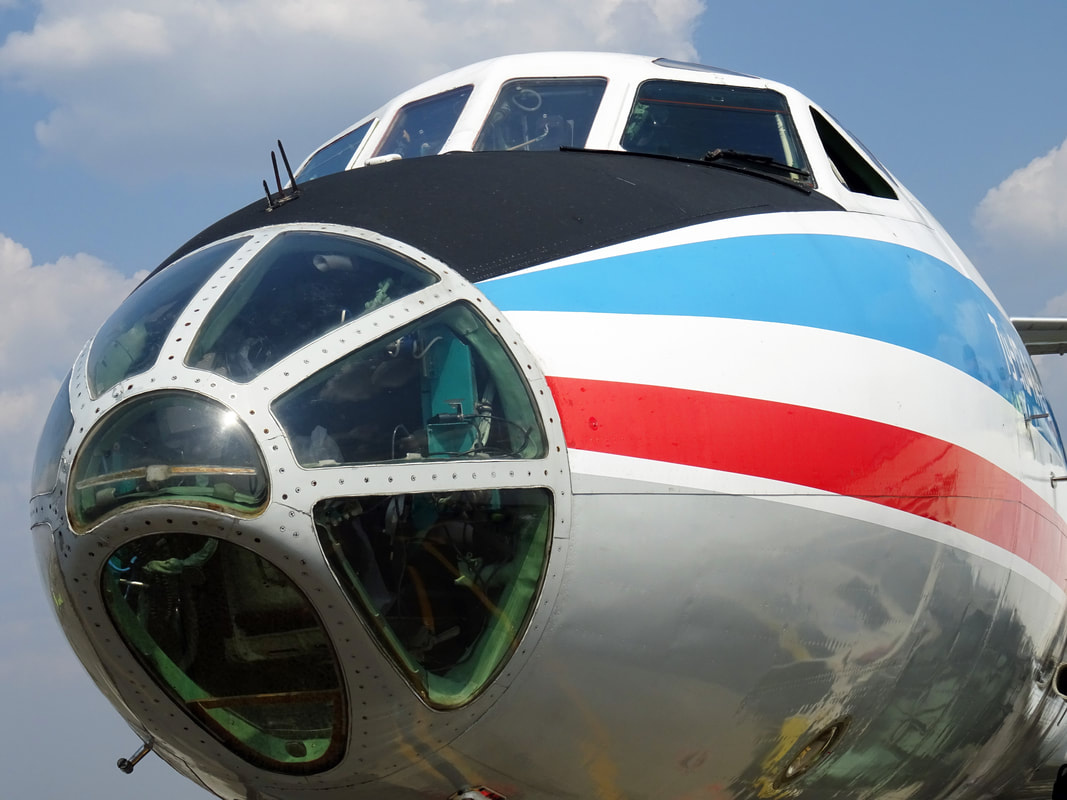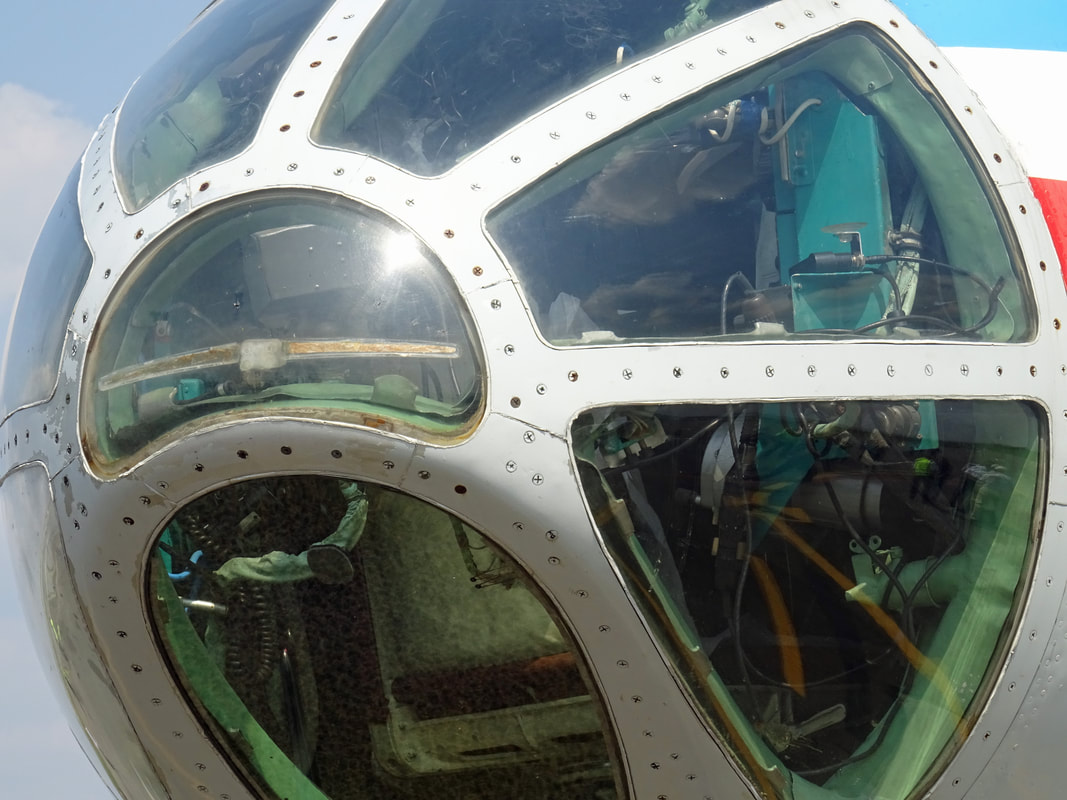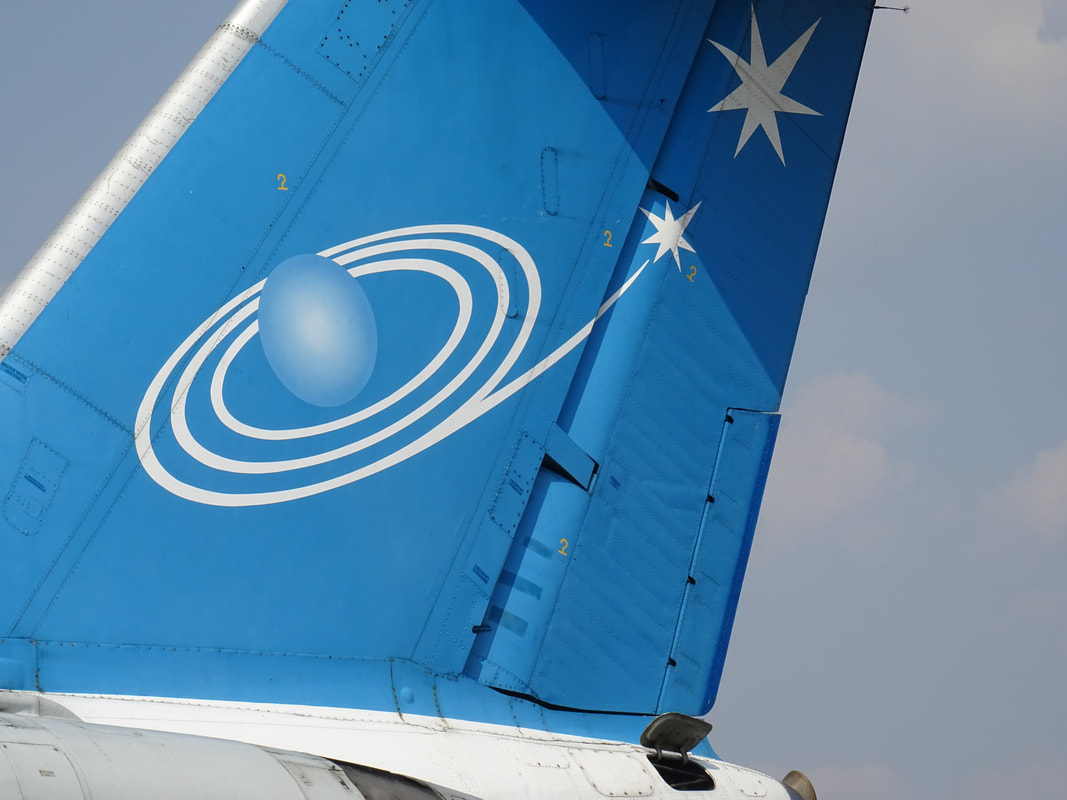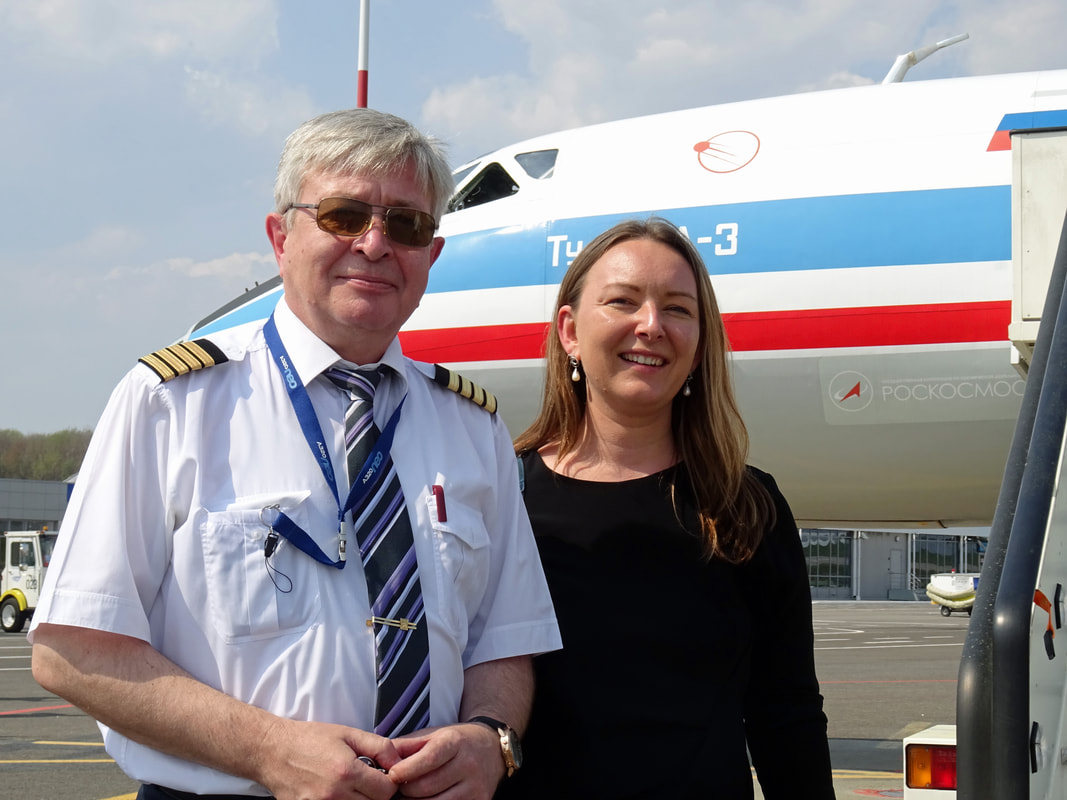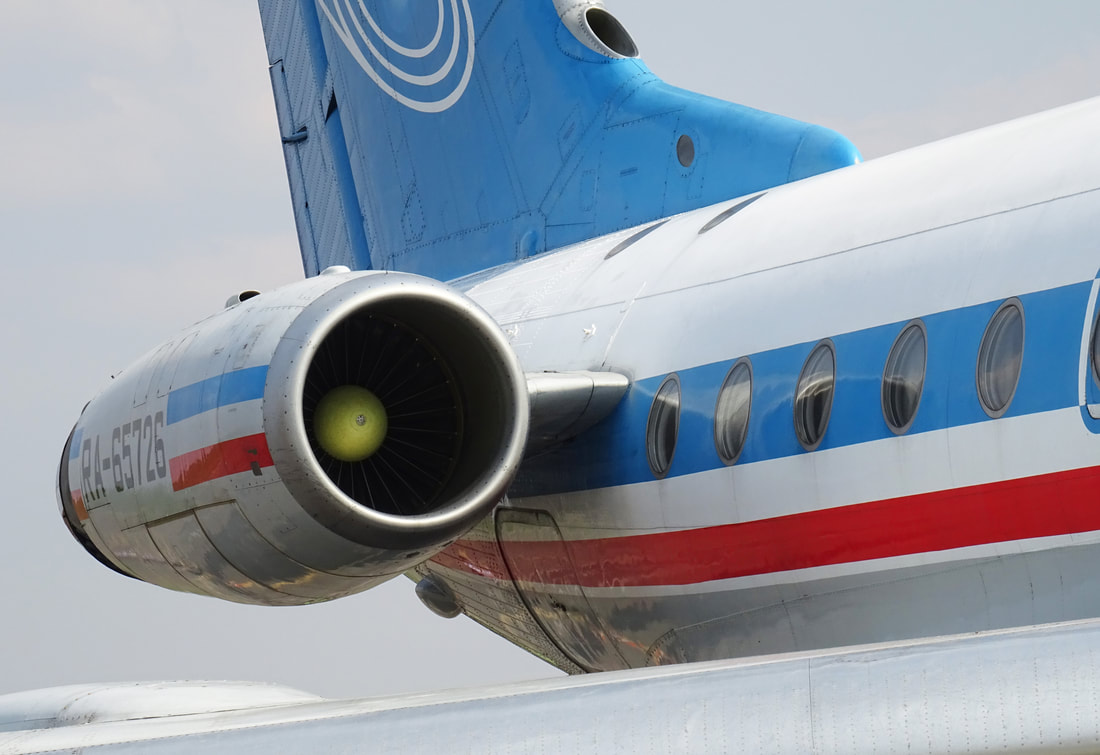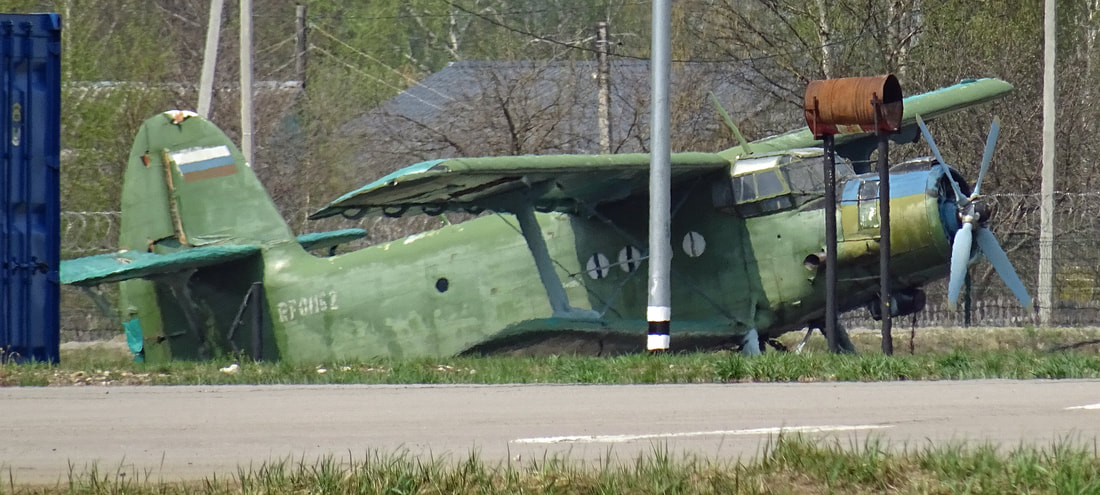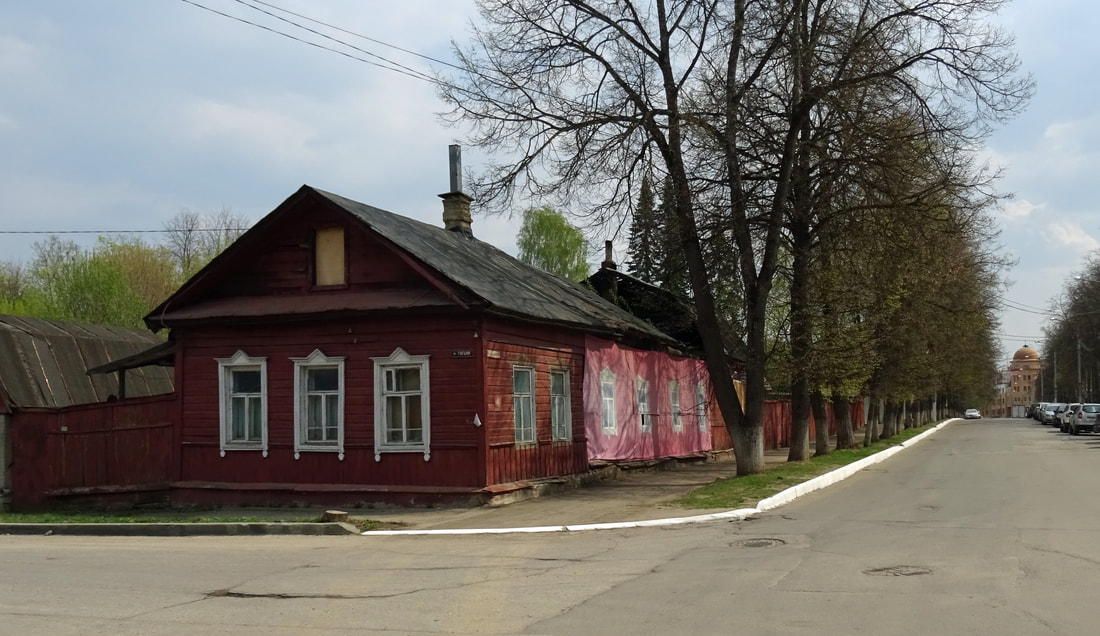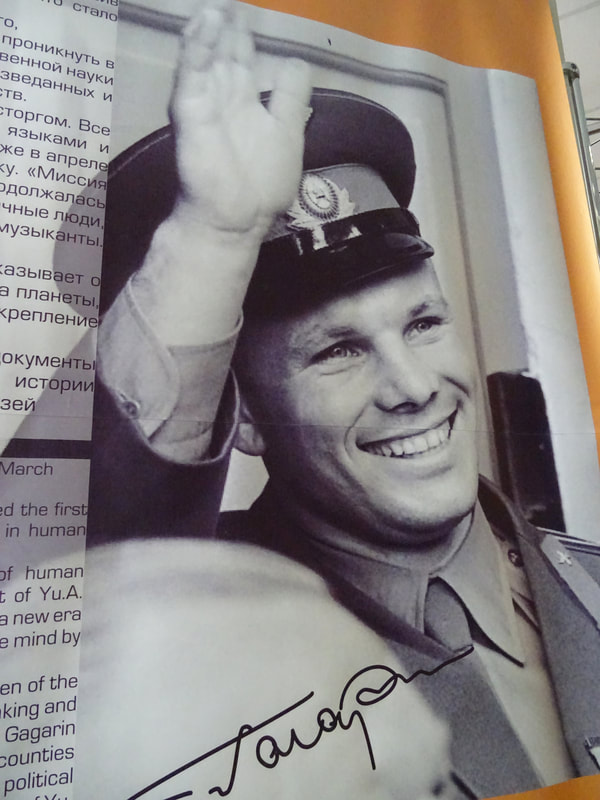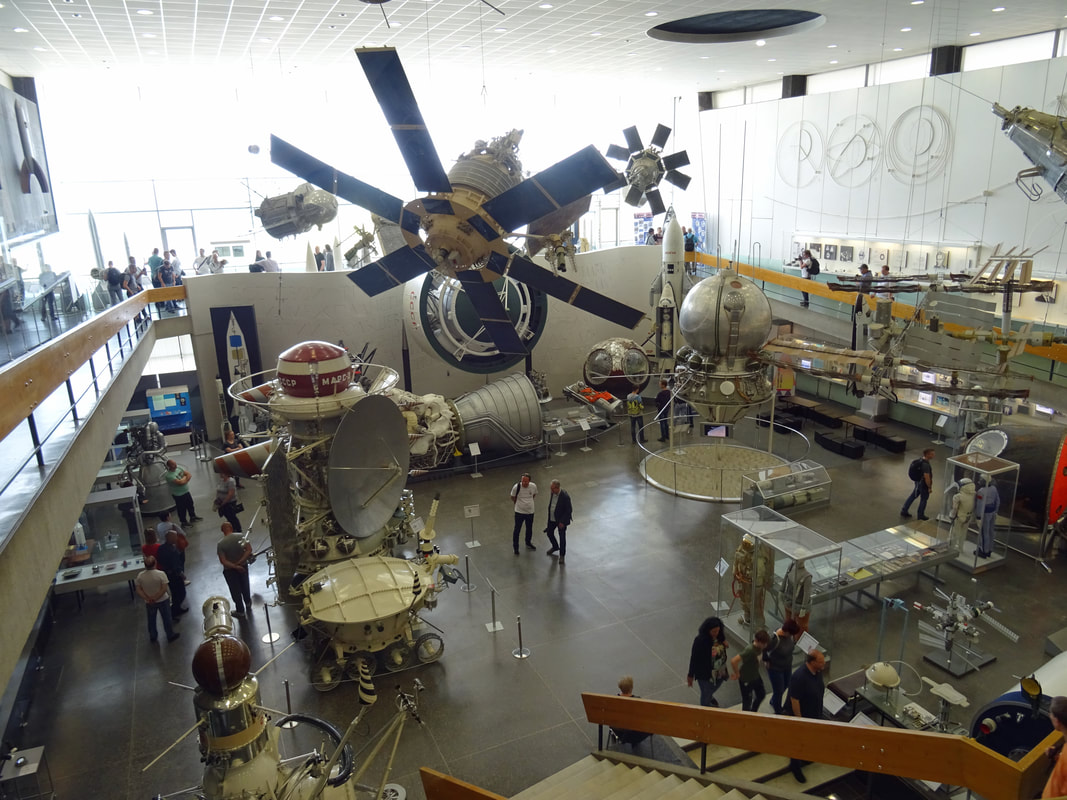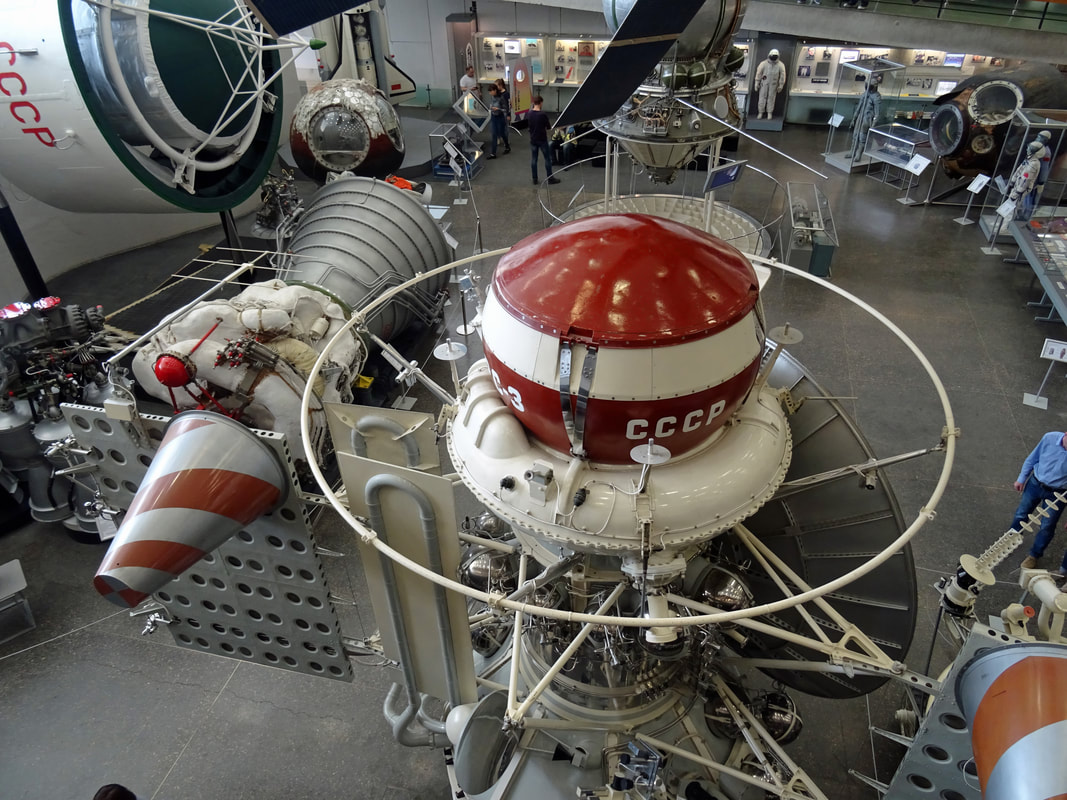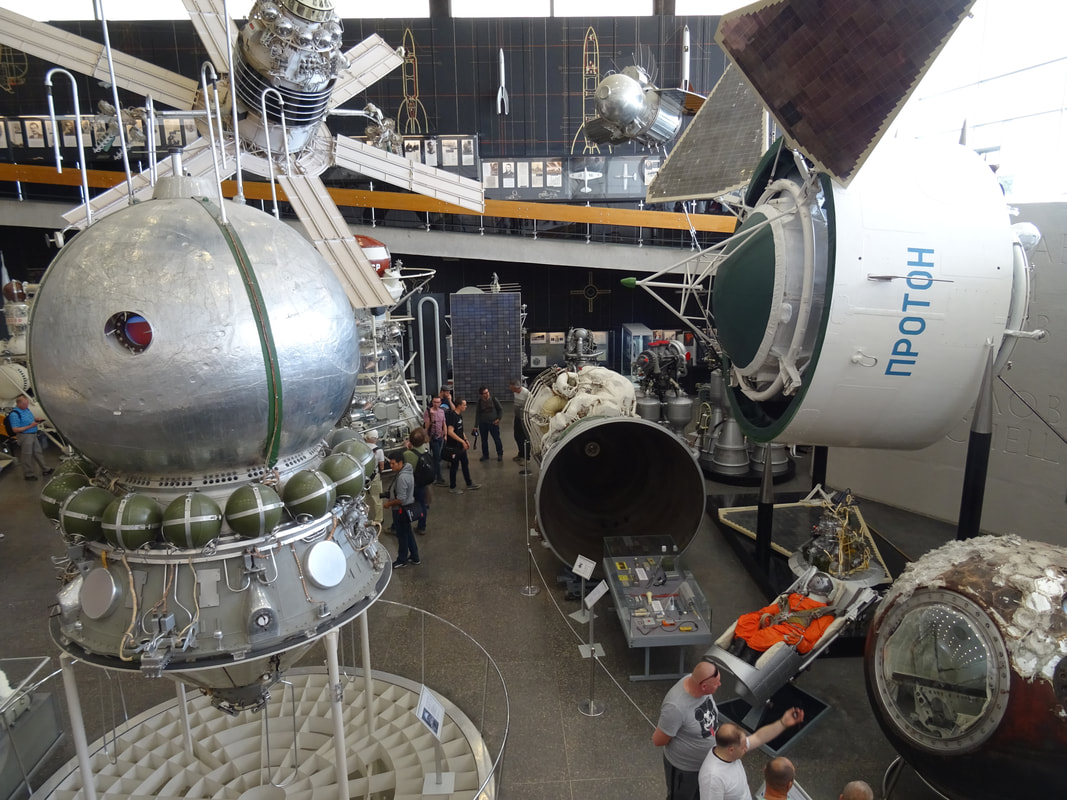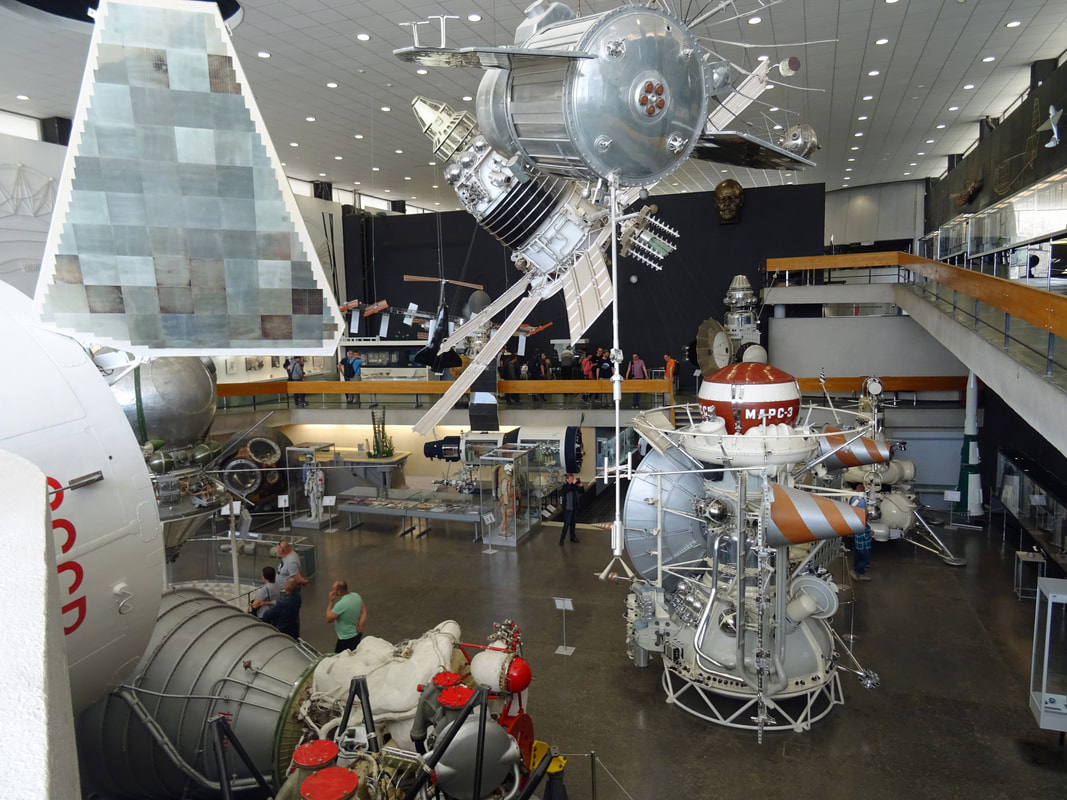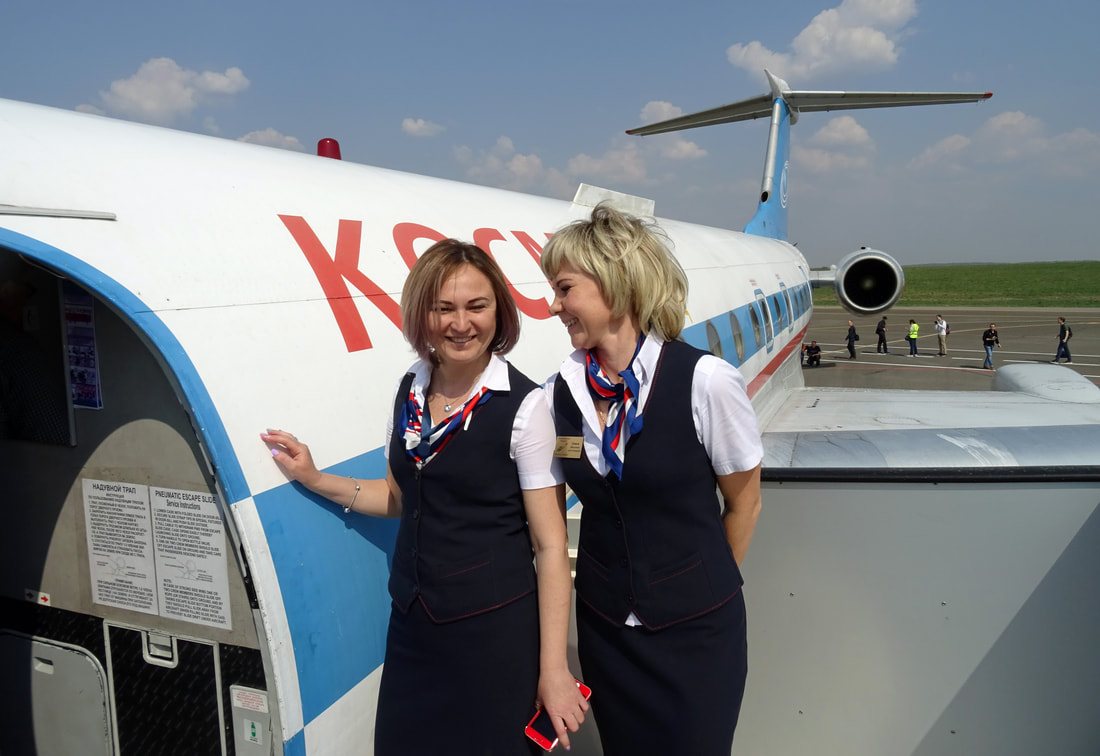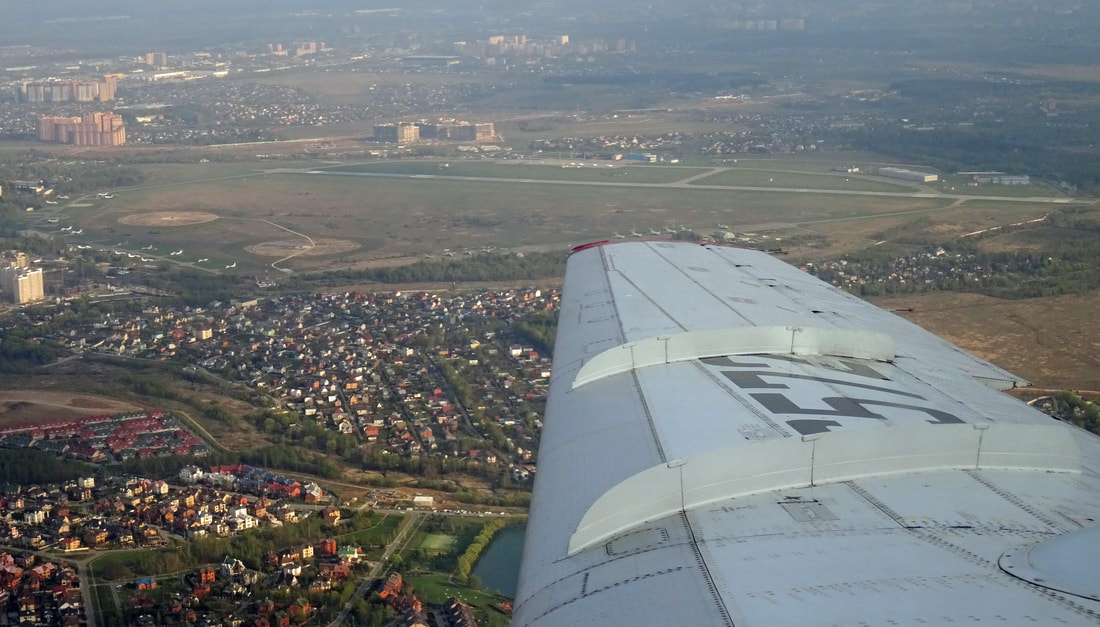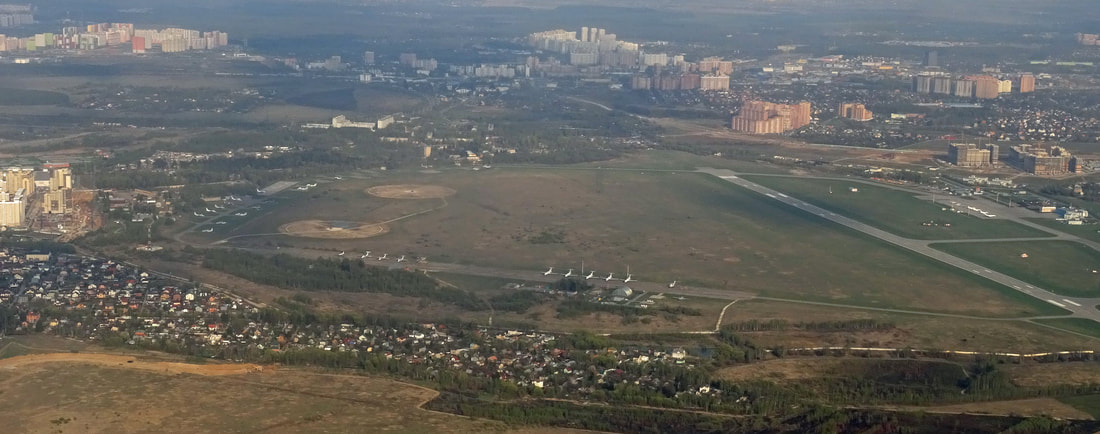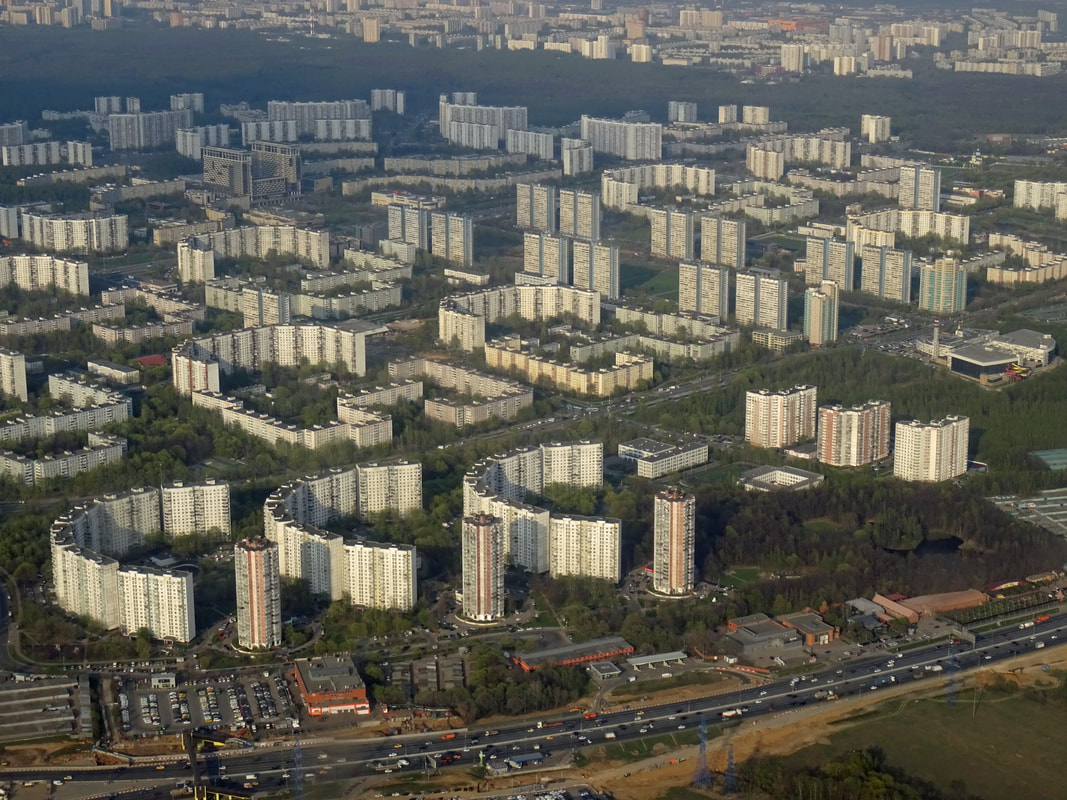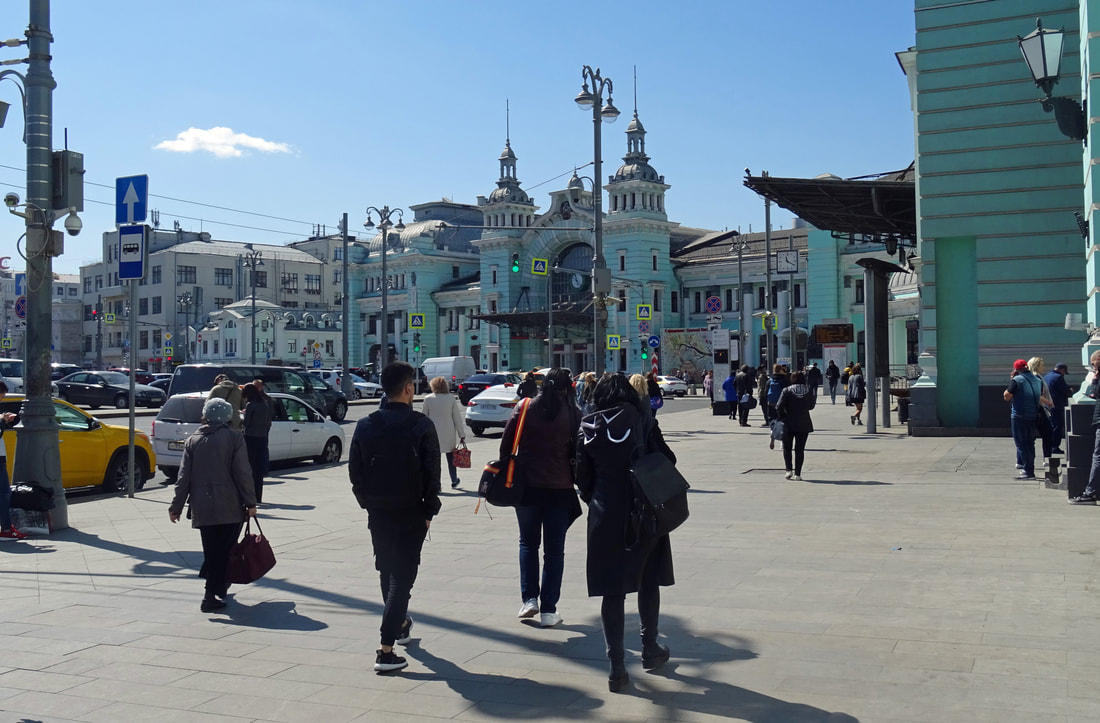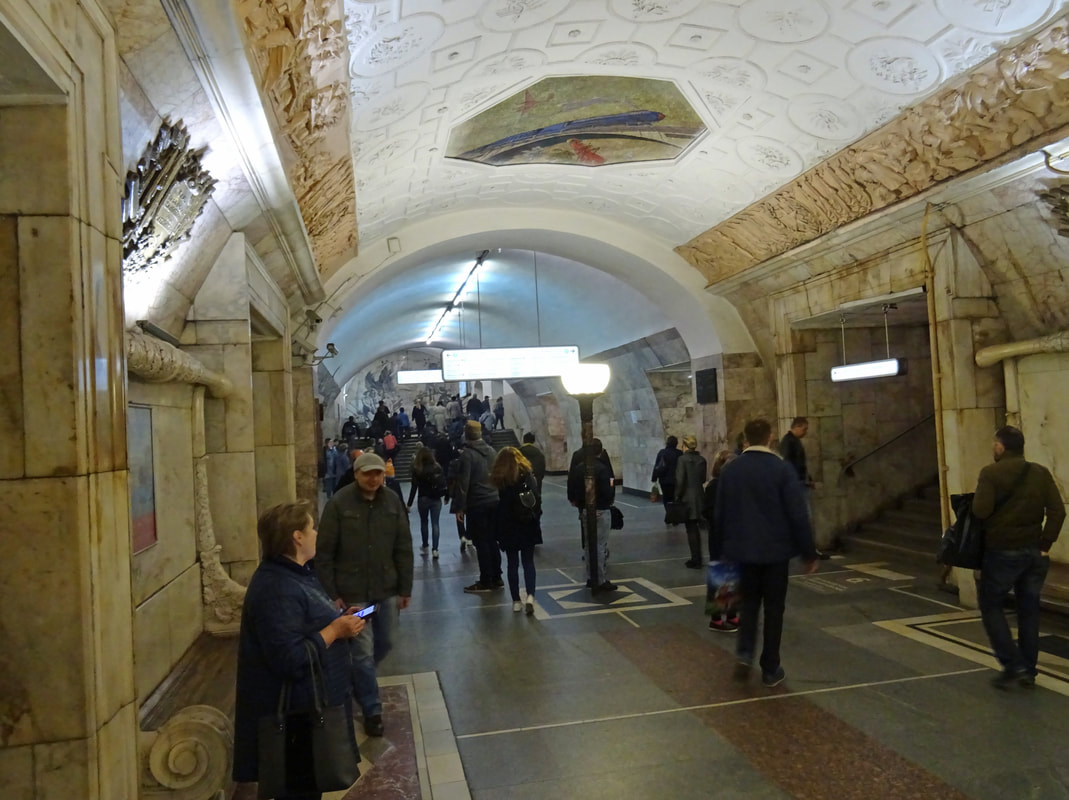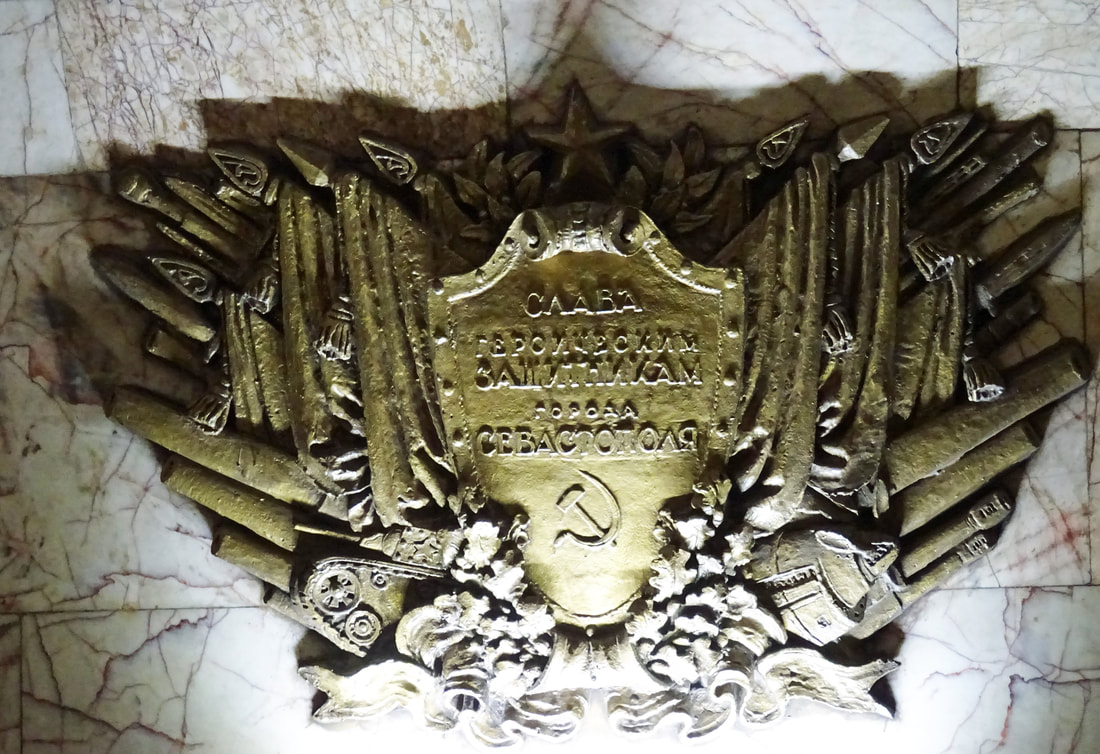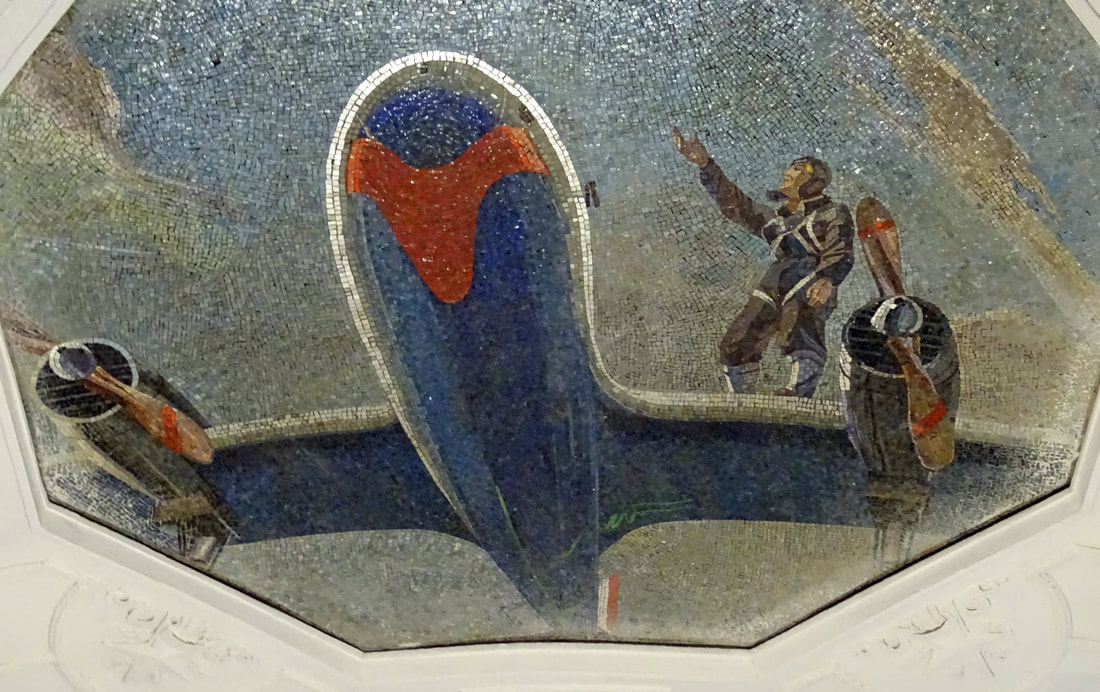'134' to Kaluga
Kosmos. The Airline of the Russian Space Agency
by Jan Koppen
In April 2019, I attended a Tu-134 flight from Moscow to Kaluga, and back. In Kaluga we visited the Russian Space Museum Visit and the city.
|
Kosmos Airlines is based at Vnukovo airport and operates an airport terminal at Vnukovo-3, called Kosmos terminal.
|
Kosmos terminal has its apron with parking ramps. It serves the aircraft of Kosmos airlines as well as other airlines at Vnukovo.
|
Kosmos Airlines is a Russian airline founded in 1995 which specializes in the delivery of cargo to launch sites.
Better art than almost every other airport terminal I’ve been to.
Kosmos Airlines was founded in 1995 as Aviacompany Kosmos. In 2001 it was renamed to Kosmos Airlines. It was operating to its Russian destinations as well as having passenger and cargo services.
One of the last remaining commercial operators of a Tupolev TU-134, including a stylish residence for the navigator in the legendary glass nose, - Kosmos - made it’s stylish 1981 borne RA-65726, available for a fun sightseeing rotation on the short hop from Moscow-Vnukovo to its astronaut training base, in the idyllic city of Kaluga, 150 km South of Moscow.
The Tupolev Tu-134 (NATO reporting name: Crusty) is a twin-engined, narrow-body, jet airliner built in the Soviet Union from 1966 to 1989. It is the world's most-produced twinjet of its class. The original version featured a glazed-nose design and, like certain other Russian airliners (including its sister model the Tu-154), it can operate from unpaved airfields.
One of the most widely used aircraft in former Comecon countries, the number in active service is decreasing because of operational safety concerns and noise restrictions. The model has seen long-term service with some 42 countries, with some European airlines having scheduled as many as 12 daily takeoffs and landings per plane. In addition to regular passenger service, it has also been used in various air force, army and navy support roles; for pilot and navigator training; and for aviation research and test projects. In recent years, a number of Tu-134s have been converted for use as VIP transports and business jets. A total of 854 Tu-134s were built of all versions (including test bed examples) with Aeroflot as the largest user; by 1995, the Tu-134 had carried 360 million passengers for that airline.
During a 1960 visit to France, Soviet leader Nikita Khrushchev was so impressed by the quiet cabin of the Caravelle, that on 1 August 1960 the Tupolev OKB received an official directive to create the Tu-124A with a similar engine arrangement. The requirement was also driven by the need to replace slow, aging piston-engined Il-14's on domestic routes. In 1961, the Soviet state airline, Aeroflot, updated its requirement specifications to include greater payload and passenger capacity.
Following the introduction of engines mounted on pylons on the rear fuselage by the French Sud Aviation Caravelle, airliner manufacturers around the world rushed to adopt the new layout. Its advantages included clean wing airflow without disruption by nacelles or pylons and decreased cabin noise. At the same time, placing heavy engines that far back created challenges with the location of the centre of gravity in relation to the centre of lift, which was at the wings. To make room for the engines, the tailplanes had to be relocated to the tail fin, which had to be stronger and therefore heavier, further compounding the tail-heavy arrangement.
Kosmos operated a fleet of three Tupolev Tu-134s and an Antonov An-12 during my visit in April 2019.
The first Tu-124A prototype, SSSR-45075, first flew on 29 July 1963. On 22 October 1963, the prototype British BAC One-Eleven, which had a similar layout, crashed with the loss of all crew while testing its stalling properties. The aircraft had entered pitch-up: the high-mounted tailplane became trapped in the turbulent wake produced by the wings (deep stall), which prevented recovery from the stall. As a result, the tailplane on Tu-124A was enlarged by 30% for greater control authority. Since Aeroflot's requirements dictated a larger aircraft than initially planned, the Soloviev Design Bureau developed the more powerful D-30 low-bypass turbofan engines. On 20 November 1963, the new airliner was designated Tu-134.
Stains caused by rain persist as seen here streaking down from the windows of Kosmos Tu-134 RA-65719.
Sistership RA-65010 is behind her and clearly in disrepair. Vnukov, April 2019.
Sistership RA-65010 is behind her and clearly in disrepair. Vnukov, April 2019.
Design curiosities of the Tu-134 included a sharp wing sweepback of 35 degrees, compared to 25–28 degrees in its counterparts. The engines on early production Tu-134s lacked thrust reversers, which made the aircraft one of the few airliners to use a brake parachute for landing. The majority of onboard electronics operated on direct current. The lineage of early Soviet airliners could be traced directly to the Tupolev Tu-16 strategic bomber, and the Tu-134 carried over the glass nose for the navigator and the landing gear fitted with low-pressure tires to permit operation from unpaved airfields.
Lovely Eighties scene at the Kosmos ramp.
Serial production began in 1966 at the Kharkov Aviation Production Association, and production of the Tu-124 was discontinued. The Tu-134 was designed for short-haul lines with low passenger traffic. Originally the aircraft had 56 seats in a single class configuration, or 50 seats in a two-class configuration.
The Tu-134 became one of the most produced and exported Soviet airliners with a whopping 854 entering service.
The Tu-134 became one of the most produced and exported Soviet airliners with a whopping 854 entering service.
Tupolev built a legendary airframe.
In 1968, Tupolev began work on an improved Tu-134 variant with a 72-seat capacity. The fuselage received a 2.1-meter (6 ft 11 in) plug for greater passenger capacity and an auxiliary power unit in the tail. As a result, the maximum range was reduced from 3,100 kilometers to 2,770 kilometers. The upgraded D-30 engines now featured thrust reversers, replacing the parachute. The first Tu-134A, converted from a production Tu-134, flew on 22 April 1969. The first airline flight was on 9 November 1970. An upgraded version, the Tu-134B began production in 1980, with the navigator position abandoned, and seating capacity increased to 96 seats. Efforts subsequently began to develop a Tu-134D with increased engine thrust, but the project was cancelled.
In September 1967, the Tu-134 made its first scheduled flight from Moscow to Adler. The Tu-134 was the first Soviet airliner to receive international certification from the International Civil Aviation Organization, which permitted it to be used on international routes. Due to this certification, Aeroflot used most of its Tu-134s on international routes. In 1968, the first export customers, Interflug of East Germany, LOT Polish Airlines and Malév Hungarian Airlines purchased the Tu-134. In 1969, the Tu-134 was displayed at the Paris Air Show.
Downtime for RA-65994, another member of the Kosmos fleet. Vnukovo, April 2019.
From 1972, Aeroflot began placing the Tu-134 in domestic service to Baku, Yerevan, Kiev, Kishinev, Krasnodar, Leningrad, Omsk, Riga, and Sochi from Sheremetyevo International Airport in Moscow.
|
Security in utter confusion!
How to stop 30+ avgeeks from taken pics of your Tu-134s. In its early years, the Tu-134 developed a reputation for reliability and efficiency, especially when compared with previous Soviet designs. After the establishment of tougher noise standards in the ICAO regulations in 2002, the Tu-134 was banned from most western European airports for its high noise levels. In early 2006, 245 Tu-134s were still in operation, 162 of which were in Russia. After a fatal accident in March 2007, and at the instigation of Russian Minister of Transportation Igor Levitin, Aeroflot announced that it would be retiring its fleet, and the last Tu-134 was removed from service on 1 January 2008. Some are still in operations with Aeroflot subsidiaries on local routes within Russia. The Tu-134 also found a new life as a business jet with many having an expensive business interior installed. High fuel and maintenance costs are increasingly limiting the number used today.
|
Russian Federation Air Force Tupolev Tu-134A-3 RA-65995, gleaming on the Kosmos apron, Vnukovo, April 2019.
In June 2011, as a response to RusAir Flight 9605 which resulted in 47 fatalities, Russian president Dmitry Medvedev ordered preparations for taking the Tu-134 out of use by 2012. On 22 May 2019, the final passenger flight of the Tu-134 in Russia took place.
Atlant Soyuz Tu-154M RA-85740 at the Kosmos ramp. Vnukovo, April 2019.
One of the last 3-holers seen at Vnukovo last April 2019.
Downtime for Barkol Aviation Yak-40 at the Kosmos ramp. Vnukovo, April 2019.
Tu-134B-3 RA-65576 is seen here near the Kosmos ramp, in an all white uniform. She started her career with Aeroflot.
Other owners were Latavio, LAT Charter and RusAir.
Other owners were Latavio, LAT Charter and RusAir.
Rus AF IL-76MD RF-76612 is seen here overflying the Kosmos ramp, while departing Vnukovo, on a saturday afternoon in late April 2019. I can still remember the deafening sound of this Soloviev D-30KP turbofan engined beast and the kerosene odor after such an earthquake take- off.
Time capsules of aviation history.
The An-12TB is cargo aircraft in the Kosmos fleet.
Jump back in time and relive the past by flying airliners that, in other countries, would have been scrapped over 20 years ago.
50+ avgeeks from all parts of the world have gathered in Moscow to sample once again the legends of Soviet Aviation History.
Our Kosmos V-2 Rocket was going to fly from Vnukvo to Kaluga on Saturday, April 27, 2019.
A bit of cosmetics is fine, but this way over! Our purser o/b flight KCM9621 to Kaluga.
|
Kosmos Tu-134A-3 with updated Soloviev D-30 turbofan engines providing power for our flight from Vnukovo to Kaluga. The perfect blend of beguiling beauty and brutal shattering power.
The Soloviev D-30 is a Soviet two-shaft low-bypass turbofan engine, officially referred to as a "bypass turbojet". It is probably the single most important turbofan engine developed in Soviet Union till date. Development of the turbofan spurred numerous growth versions with increased fan diameter and modified component arrangements. Developed within an amazingly short period of time (about three years), the engine turned out to be one of the most reliable engines in the history of Soviet engine development.
|
Avgeeks at work o/b our Kosmos Tu-134A-3.
Off it was, on a bright sunny Saturday, at end of April 2019. We were rocketing down to Kaluga in merely 30 minutes, bringing back memories from our more glorious aviation past back in the 70s and 80s, from times when we were young, pure and innocent and flying onboard these submarine like shaped rockets was no less an adventure than today.
|
Russian planes of a certain vintage have windows on weird places.
The TU-134 has a skylight in some rooms, an hold-over from when USSR lacked automated nav-aides. |
During a 1960 visit to France, Soviet leader Nikita Khrushchev was so impressed by the quiet cabin of the Caravelle, that on 1 August 1960 the Tupolev OKB received an official directive to create the Tu-124A with a similar engine arrangement. The requirement was also driven by the need to replace slow, aging piston-engined Il-14s on domestic routes. In 1961, the Soviet state airline, Aeroflot, updated its requirement specifications to include greater payload and passenger capacity.
|
'Keep your cool' is what this russian CA told me when serving 40+ avgeeks o/b her hard working Tu-134.
Because I did not have a seat in the truly Premium cabin – the only service I had on offer was water. Yet this did not upset me. This is one of those flights where I spent more of my time standing and taking pictures than wanting a snack.
After what felt like an instance, we began our descent into Kaluga airport.
Ofcourse, I had to make a customary flight deck visit.
The Tu-134 cockpit, a capsule from halcyon days!
Her switches and controls, worn smooth by the touch of a thousand hands!
Looking through the nose of our Tu-134A
Kosmos is one of the last remaining commercial operators of a Tupolev TU-134A, including a stylish residence for the navigator in the legendary glass nose. Kosmos Airlines made it’s stylish, 1981 borne RA-65726, available for a fun sightseeing rotation on the short hop from Moscow-Vnukovo to its astronaut training base in the idyllic city of Kaluga, 150 km South of Moscow.
After parking, I got up once more to check out the area of the Tu-134.
Arrival at Kaluga Airport.
Another distinctive element is the wing. Beyond its 35 degrees sweep, it has boundary layer control fences more akin to a heavy interceptor than a civilian airliner. This makes it incredibly quick and also contributes to a unique ride.
|
Kaluga is called the cradle of cosmonautics due to its links with the scientist Konstantin Tsiolkovsky - one of the founding fathers of Russian cosmonautics - and many of its main sights are connected with this. You can visit Kaluga as a day trip from Moscow or combine it with travelling around other cities of the Kaluga Region.
|
Tu-134s are getting harder to find within Russia.
Top dressed! RA-65726 is a particularly handsome example.
Tupolev Tu-134A-3 RA-65726 sitting pretty at Kaluga.
Prior to Kosmos acquiring this aircraft, it was operated by the Federal Security Service. Before that; it belonged to the Russian State Transport Company. Before that, it served a similar role within the Soviet Air Force’s VIP flight detachment out of Vnukovo, where it is still based.
As an airport hound in my younger years, I saw and remember many, many Tupolev Tu-134's, on the
ramp of Amsterdam-Schiphol airport and also flying west out over my parents house in Vogelenzang.
ramp of Amsterdam-Schiphol airport and also flying west out over my parents house in Vogelenzang.
Kosmos Airlines, which will now be a part of Roscosmos, will continue providing air transportation services to all Russian enterprises engaged in the rocket and space industry, according to TASS newswire. A new generation of Tupolev aircraft, the Tu-204-300, entered the carrier’s fleet. The aircraft will be operated in the interests of Russia’s state defense corporation Rosoboronexport.
Kosmos TU-134A RA-65726 nose close up, at Kaluga, Russia. April 2019.
Kosmos Tu-134A-3 close-up. Kaluga, April 27, 2019.
|
Because of its lineage, based on military aircraft, the Tu-134A provided a glass nose for a navigator position, providing them with a clear view of the ground ahead.
Another oft mentioned advantage of the glass nose was that the aircraft could easily be fitted with cameras to operate as spy planes during Aeroflot flights over western Europe, and I remember hearing of several cases where Aeroflot 134's and 154's with glass noses were investigated and cameras found after having "gotten lost" on their regular routes and "just happened" to fly over NATO installations. |
The Soloviev D-30's are resting after our short hop.
|
Yuri Alekseyevich Gagarin (9 March 1934 – 27 March 1968) was a Soviet Air Forces pilot and cosmonaut who became the first human to journey into outer space, achieving a major milestone in the Space Race; his capsule Vostok 1 completed one orbit of Earth on 12 April 1961. Gagarin became an international celebrity and was awarded many medals and titles, including Hero of the Soviet Union, his nation's highest honour.
Born in the village of Klushino near Gzhatsk (a town later renamed after him), in his youth Gagarin was a foundryman at a steel plant in Lyubertsy. He later joined the Soviet Air Forces as a pilot and was stationed at the Luostari Air Base, near the Norwegian border, before his selection for the Soviet space programme with five other cosmonauts. |
|
The Konstantin E. Tsiolkovsky State Museum of the History of Cosmonautics is the first museum in the world dedicated to the history of space exploration. It was opened on 3 October 1967 in Kaluga, and is named after Konstantin Tsiolkovsky, a school master and rocket science pioneer who lived most of his life in this city. The driving force behind the creation of the museum was Sergei Korolyov, chief designer of RKK Energiya. The building was designed by Boris Barkhin, Evgeny Kireev, Nataliya Orlova, Valentin Strogy and Kirill Fomin, and the cornerstone was laid by Yuri Gagarin on 13 June 1961. The museum has over 100,000 visitors per year.
|
Beautiful and elegant, the cabine crew and the Tu-134 consited of Mrs. Julia Rudich and Miss Irina Sacharova.
The return flight took place in beautiful afternoon sunshine and included
a full left turn over the Southern suburbs of the megapolis city of Moscow.
a full left turn over the Southern suburbs of the megapolis city of Moscow.
Ostafyevo International Business Airport is a "B" class international airport, located 14 kilometres (8.7 mi) to the south of Moscow Ring Road. The airport is owned by Gazpromavia company, a division of Gazprom. It was renovated and opened for civilian flights in 2000 on the grounds of a former military airbase. Ostafyevo features a new modern glass terminal, and caters primarily to business aviation.
It is capable of receiving aircraft Boeing 737-700, Global 5000/6000/Express, Falcon-900/2000/7X, An-12/74, Il-18, Yak-42, SJ-100, Tu-134 (noise restrictions) and more light, as well as helicopters of all types.
It is capable of receiving aircraft Boeing 737-700, Global 5000/6000/Express, Falcon-900/2000/7X, An-12/74, Il-18, Yak-42, SJ-100, Tu-134 (noise restrictions) and more light, as well as helicopters of all types.
This is Moscow!
... and this is Moscow!
... and this is also Moscow!
The Moscow Metro was one of the USSR's most ambitious architectural projects. The metro's artists and architects worked to design a structure that embodied svet (radiance or brilliance) and svetloe budushchee (a radiant future). With their reflective marble walls, high ceilings and grand chandeliers, many Moscow Metro stations have been likened to an "artificial underground sun". This palatial underground environment reminded riders that their tax rubles had been well spent on svetloe budushchee.
So, to conclude, if you get an opportunity to fly on a Tu-134 of any variant – do it!

